“The wars of the 21st Century will be fought over water.” —Ismail Serageldin, World Bank

Last Call at the Oasis film poster ©2012, Participant Media, all rights reserved.
Watching the devastation and havoc caused by Hurricane Sandy and several recent water-related natural disasters, it’s hard to imagine that global water shortages represent an environmental crisis on par with climate change. But if current water usage habits do not abate, or if major technological advances to help recycle clean water are not implemented, this is precisely the scenario we are facing—a majority of 21st Century conflicts being fought over water. From the producers of socially-conscious films An Inconvenient Truth and Food, Inc., Last Call at the Oasis is a timely documentary that chronicles current challenges in worldwide water supply, outlines the variables that contribute to chronic shortages and interviews leading environmental scientists and activists about the ramifications of chemical contamination in drinking water. More than just an environmental polemic, Last Call is a stirring call to action for engineering and technology solutions to a decidedly solvable problem. A ScriptPhD.com review under the “continue reading” cut.
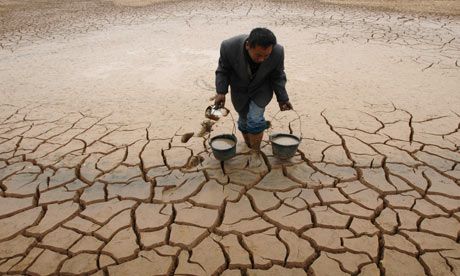
A man in China hauls two buckets of water during a severe drought. Ongoing, frequent droughts represent a huge threat to China’s agricultural industry.
Although the Earth is composed of 70% water, only 0.7% (or 1% of the total supply) of it is fresh and potable, which presents a considerable resource challenge for a growing population expected to hit 9 billion people in 2050. In a profile series of some of the world’s most populous metropolises, Last Call vividly demonstrates that stark imagery of shortage crises is no longer confined to third world countries or women traveling miles with a precious gallon of water perched on their heads. The Aral Sea, a critical climate buffer for Russia and surrounding Central Asia neighbors, is one-half its original size and devoid of fish. The worst global droughts in a millennium have increased food prices 10% and raised a very real prospect of food riots. Urban water shortages, such as an epic 2008 shortage that forced Barcelona to import emergency water, will be far more common. The United States, by far the biggest consumer of water in the world, could also face the biggest impact. Lake Mead, the biggest supplier of water in America and a portal to the electricity-generating Hoover Dam, is only 40% full. Hoover Dam, which stops generating electricity when water levels are at 1050 feet, faces that daunting prospect in less than 4 years!
One strength of Last Call is that it is framed around a fairly uniform and well-substantiated hypothesis: water shortage is directly related to profligate, unsustainable water usage. Some usage, such as the 80% that is devoted to agriculture and food production, will merit evaluation for future conservation methods. California and Australia, two agricultural behemoths half a world apart, both face similar threats to their industries. But others, such as watering lawns. are unnecessary habits that can be reduced or eliminated. Toilets, most of which still flush 6 gallons in a single use, are the single biggest user of water in our homes—6 billion gallons per day! The US is also the largest consumer of bottled water in the world, with $11 billion in sales, even though bottled water, unlike municipal tap water, is under the jurisdiction of the FDA, not the EPA. As chronicled in the documentary Tapped, 45% of all bottled water starts off as tapped water, and has been subject to over 100 recalls for contamination.

Gravity field anomalies measured through the GRACE Satellite provide information about changes in the Earth’s water levels.
A cohort of science and environmental experts bolsters Last Call’s message with the latest scientific research in the area. NASA scientists at the Jet Propulsion Laboratory are using a program called the Gravity Recovery and Climate Experiment (GRACE) Satellite to measure the change in oceans, including water depletion, rise in sea levels and circulation through a series of gravity maps. Erin Brockovich, famously portrayed by Julia Roberts in the eponymous film, appears throughout the documentary to discuss still-ongoing issues with water contamination, corporate pollution and lack of EPA regulation. UC Berkeley marine biologist Tyrone Hayes expounds on what we can learn from genetic irregularities in amphibians found in contaminated habitats.
Take a look at a trailer for Last Call at the Oasis:
Indeed, chemical contamination is the only issue that supersedes overuse as a threat to our water supply. Drugs, antibiotics and other chemicals, which cannot be treated at sewage treatment plants, are increasingly finding their way into the water supply, many of them at the hands of large corporations. Between 2004 and 2009, there were one half a million violations of the Clean Water Act. Last Call doesn’t spare the eye-opening details that will make you think twice when you take a sip of water. Atrazine, for example, is the best-selling pesticide in the world, and the most-used on the US corn supply. Unfortunately, it has also been associated with breast cancer and altered testosterone levels in sea life, and is being investigated for safety by the EPA, with a decision expected in 2013. More disturbing is the contamination from concentrated animal feeding operations (CAFOs) near major rivers and lakes. Tons of manure from cows, one of which contributes the waste of 23 humans, is dumped into artificial lagoons that then seep into interconnected groundwater supplies.
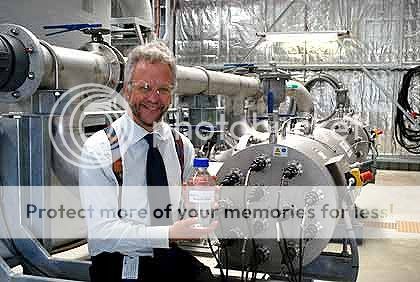
A scientist holds a bottle of water filtered and purified through reverse osmosis at a sewage recycling plant. Would you drink it?
It’s not all doom and gloom with this documentary, however. Unlike other polemics in its genre, Last Call doesn’t simply outline the crisis, it also offers implementable solutions and a challenge for an entire generation of engineers and scientists. At the top of the list is a greater scrutiny of polluters and the pollutants they release into the water supply without impunity. But solutions such as recycling sewage water, which has made Singapore a global model for water technology and reuse, are at our fingertips, if developed and marketed properly. The city of Los Angeles has already announced plans to recycle 4.9 billion gallons of waste water by 2019. Last Call is an effective final call to save a fast-dwindling resource through science, innovation and conservation.
Last Call at the Oasis went out on DVD November 6th.
~*ScriptPhD*~
*****************
ScriptPhD.com covers science and technology in entertainment, media and advertising. Hire our consulting company for creative content development.
Subscribe to free email notifications of new posts on our home page.
]]>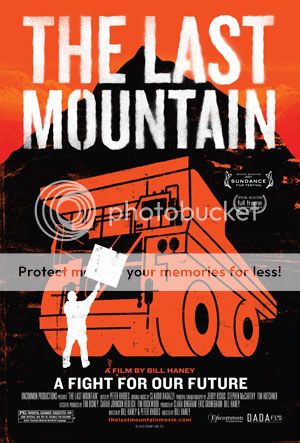
Mountaintop Removal poster ©2011 Solid Ground Films, all rights reserved.
About a year ago, a little publicized, unheralded documentary named Mountaintop Removal (which ScriptPhD.com reviewed) attempted to deconstruct the environmentally devastating practice of the same name literally destroying the Appalachian geography of West Virginia’s coal river valley. Honest, yet modestly shot and produced, the small-scale documentary needed a Hollywood touch to resonate on a human level to advance its powerful cause. It got what it needed in The Last Mountain, a celebrated selection of this year’s Sundance Film Festival. This important new documentary succeeds in both relaying the urgency of a destructive coal mining practice that is literally zoning in on one last undamaged mountain as well as forging a human connection with the townspeople battling to save it. Full ScriptPhD.com review under the “continue reading” cut.
Most people don’t think twice about where the electricity for their light bulbs comes from. Or if they know it primarily comes from coal, they are not aware of how that coal comes to see the light of day. In the valleys and mountaintops of idyllic Appalachia, the coal industry detonates the explosive power of a Hiroshima bomb every week, utilizing a crude process called mountaintop removal. There is nothing scientific or technical about mountaintop removal. It is crude, cruel and its effects non-reversible. First, trees and other natural ecology are removed from the tops of mountains. Then, dynamite splits the mountain open to unearth a layer of coal that is mined by brave men risking their lives in ungodly working conditions. When the layer is depleted, the next layer is blasted, until nothing is left but a hollow shell of a devastated mountain. In its wake, the process leaves behind toxic sludge piles containing arsenic, lead and mercury, contaminated rivers and streams, fine particulate airborne matter that creates an epidemiological health nightmare, and unlivable communities. Mountaintop removal has already destroyed 500 Appalachian mountains, decimated 1 million acres of forests, and buried 2,000 miles of streams.
Take a look at a clip from The Last Mountain that shows the destruction from an aerial view:
In the beautiful mountains of the Coal River Valley in West Virginia, mining corporations such as Massey Energy are blasting the mountains of Appalachia into extinction, polluting the air and water with blithe impunity, and amassing the kind of profits that allow them to wield massive lobbying power in Washington, DC to both repeal existing environmental regulations and obviate the ratification of new ones. One small community has had enough. Their only schoolhouse sits at the base of a silo where 28 million gallons of toxic sludge left over from the coal mining are held back by a flimsy levee. Their neighbors and friends—ranging from 5 to 63 years old to—are dying in masses from strange tumor clusters. Water filters that should last 3-4 months get plugged up after two weeks. The very last mountain in Coal River, protecting the community from massive flooding after rainfall, is being targeted for blasting. And that is when the people of Coal River decide to fight back.
The Last Mountain is not just a standard environmental cautionary tale, but also an uplifting tale of citizens taking back their community. Helping the cause is noted environmentalist Robert F. Kennedy, Jr., who travels to Coal River, aligns with the community, and attends dozens of rallies that are held to protest the actions of Massey Energy. In one of the film’s lighter moments, a humble West Virginian remarks “I never thought I’d have a Kennedy in my living room!” It is these very human moments that ultimately connect the audience to a cause seemingly unrelated to our lives. The most poignant moment of The Last Mountain is live footage of Coal River residents that had traveled to the governor’s offices in Charlotte to present him with money raised through a local Pennies For Promise campaign to build a new, safer schoolhouse (an ultimately successful initiative.) At first the governor is touched, even amused, by the rural denizens. But when they bring up the actions of Massey Energy, and the governor’s own futility in stopping the damage to their community, he is stunned, even embarrassed, even going so far as to have the West Virginia government arrest the protesters—one of whom was a 91-year-old woman in a flag-draped wheelchair. “Why are our kids any different?” former Massey Energy contractor turned activist Ed Wiley shouts at the governor. “Because they’re in the coal fields? They’re on the wrong side of the mountain?”
If you think this movie, or mountaintop removal itself, doesn’t affect you, you’re wrong. Almost half of the electricity produced in the US comes from the burning of coal (that’s 16 pounds of coal each day for each man, woman, and child!). 32% of that coal comes from…you guessed it…the mountains of Appalachia. It also happens to be the #1 sources of greenhouse gases worldwide. And it doesn’t stop there. The toll on health from the burning of coal nationwide—contributing to such problems as 10 million asthma attacks, brain damage in newborns and thousands of premature deaths—adds up to $345 billion annually. We are all paying the cost of mountaintop removal in one way or another. You’re connected to coal, whether you realize it or not.
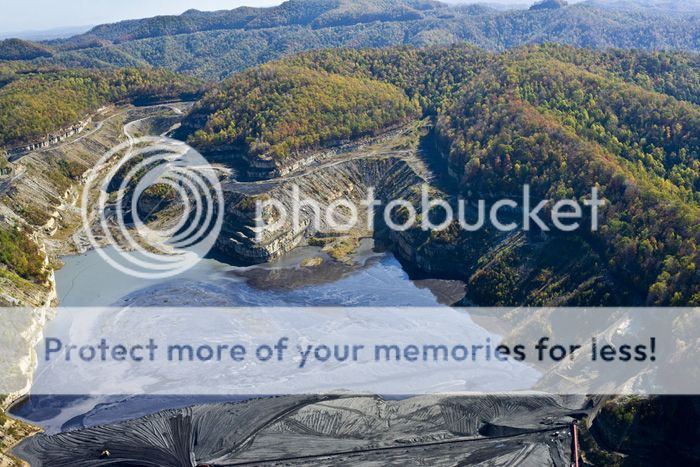
Toxic sludge sits at the base of a mountain that has been mined for coal in a scene from The Last Mountain.
As The Last Mountain eventually conveys, this is a tale about so much more than blasting off a mountain—it’s about hubris and powerful people thinking they can do whatever they want, while destroying lives in the process. How’s this for a silent statistic? Massey Energy’s 28 impoundments have spilled 24 times in the last decade, contaminating rivers with 300 million gallons of sludge—that is twice the amount released in the BP oil spill in the Gulf that shocked the world. After a $28 million dollar settlement for their environmental violations, Massey Energy committed 180 more violations with no impunity. And the tragic thing is that the alternative technology is so much more effective and inexpensive. The filmmakers end with an uplifting visit to Portsmouth, WV, a municipality that supplies ¾ of its electricity needs for the community with two windmills with low-grade Category 2 winds. The winds in the Coal River Valley? The highest possible—Category 5. One can only imagine how many jobs and clean energy could be created from wind turbines in the Coal River Valley. A 1991 Department of Energy study concluded that only three US States, Kansas, North Dakota and Texas, have enough harnessable wind energy to supply the entire nations energy needs. Twenty years later, we have the technology to make it happen.
The ultimate message of The Last Mountain is that is not enough to simply be outraged anymore. We are all users of the electricity and power that is generated from the sacrifices of the Appalachia residents and miners. The imagery of environmental devastation is so shocking, the deregulation and egregious indifference of the coal mining companies’ various violations so appalling, that we begin to feel somehow complicit in perpetrating this modern American tragedy. Fixing it starts with watching documentaries like The Last Mountain, but also in taking the kind of inspiring action as that of the small rural West Virginia community that the film portrays. Ordinary people, banded together in a common purpose, can indeed move mountains. And sometimes, they can even save them.
Trailer:
The Last Mountain was released in limited screenings on June 15th, and goes into theaters nationwide later in June.
~*ScriptPhD*~
*****************
ScriptPhD.com covers science and technology in entertainment, media and advertising. Hire our consulting company for creative content development.
Subscribe to free email notifications of new posts on our home page.
]]>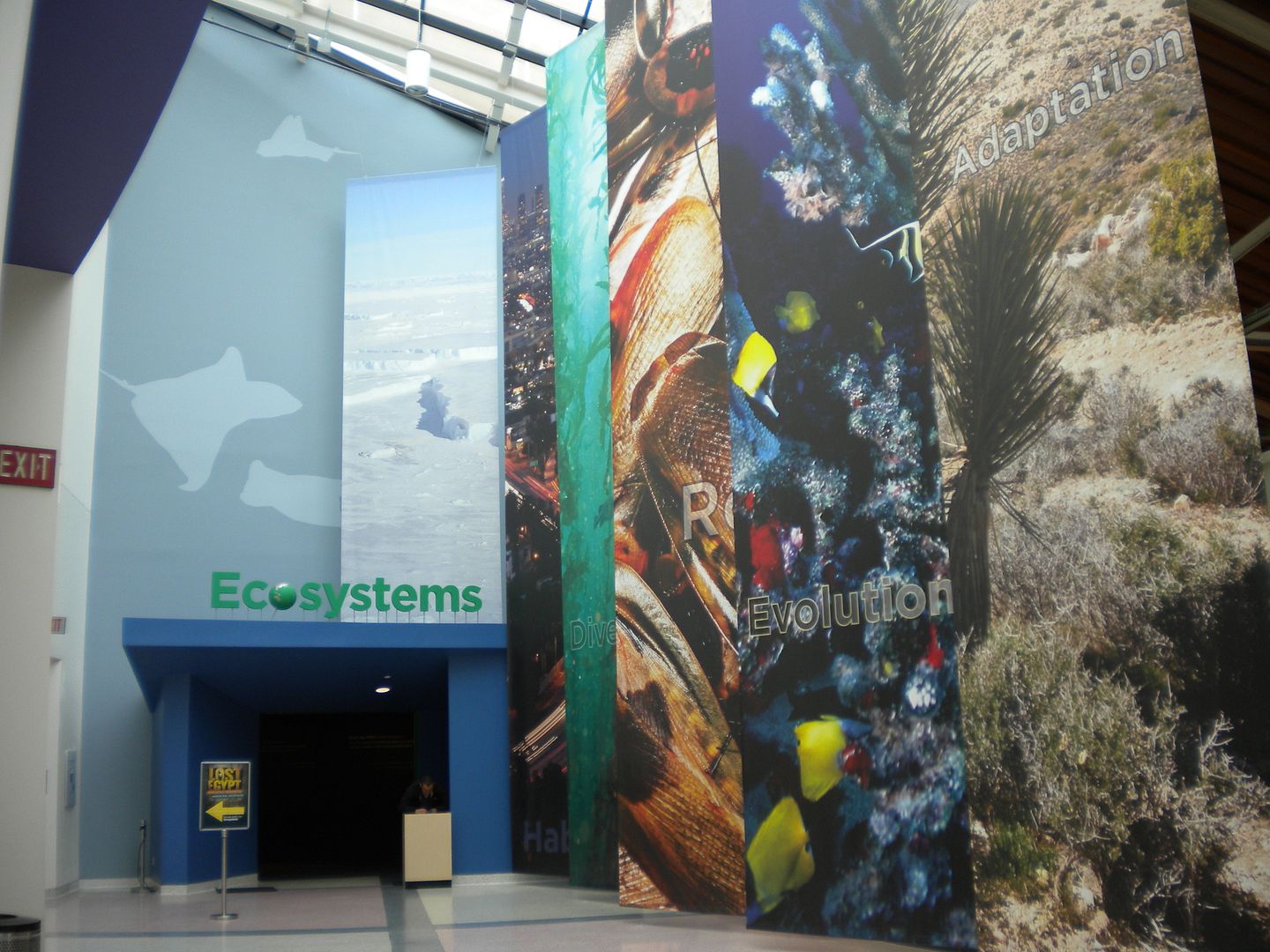
The free 'Ecosystems' exhibit at the California Science Center. Photography ©2011 ScriptPhD.com, all rights reserved.
Approximately a year ago, the California Science Center added a 45,000 square foot permanent exhibit called ‘Ecosystems,’ nearly doubling the size of the museum. Ten years in the making, at a cost of $165 million, ‘Ecosystems’ manages to impress visually and scholastically. ScriptPhD.com recently got a private tour and in-depth guide of the ambitious exhibit and didactic tool. Afterwards, we had the opportunity to sit down with the man that conceptualized ‘Ecosystems’ and curator of ecology at the California Science Center — Dr. Chuck Kopczak. An avid geologist, and devoted to the promulgation of quality science education, Dr. Chuck graciously sat down with us for an in-depth conversation about ‘Ecosystems,’ the future of science education, and energizing environmental causes through science. Our full tour and podcast, under the “continue reading” cut.
How can we protect and nurture our Earth’s diverse environment if we don’t even know about it? The Earth’s biodiversity is spectacular, with a singular globe housing millions of unique species that have to share space across extreme environments, weather zones and poles. Scientists concur that a better understanding of this diversity, and humanity’s impact on it through our modern life (we add 7 million people to the globe each month!), is an essential component of environmental education and effective activism in fighting pollution and effecting sustainability for future generations. In the heart of Los Angeles, at its most-visited museum, The California Science Center, lies a new exhibit that takes curious visitors through the various ‘zones’ of the Earth’s habitats, with each room providing a colorful, interactive, informative peek at what survival entails. At the very end of the ‘Ecosystems’ exhibit, after we have come to appreciate our Earth’s uniqueness, beauty, and scientific breadth, is a well-timed section on waste, resources, and the power of recycling. Come take a short pictorial tour of ‘Ecosystems’ with us, and then take a listen to our podcast with the passionate scientist, Dr. Chuck Kopczak, that made it all possible.
‘Ecosystems’ is divided into rooms called ‘Zones,’ some of which we’ve documenting here, consisting of a gallery that engenders appreciation for the interconnectedness of a different part of our living world. Portrayed are different environments, species, survival demands, and physical factors. All of the rooms include interactive, hands-on experiments especially tailored for kids.
The ‘Island Zone’ includes hands-on experiments that allow visitors to see the challenge animals face in getting to an island from water, and how their physical characteristics evolve as a result of these environmental demands. The exhibit mimics the discoveries that Darwin might have encountered on the Galapagos Islands.
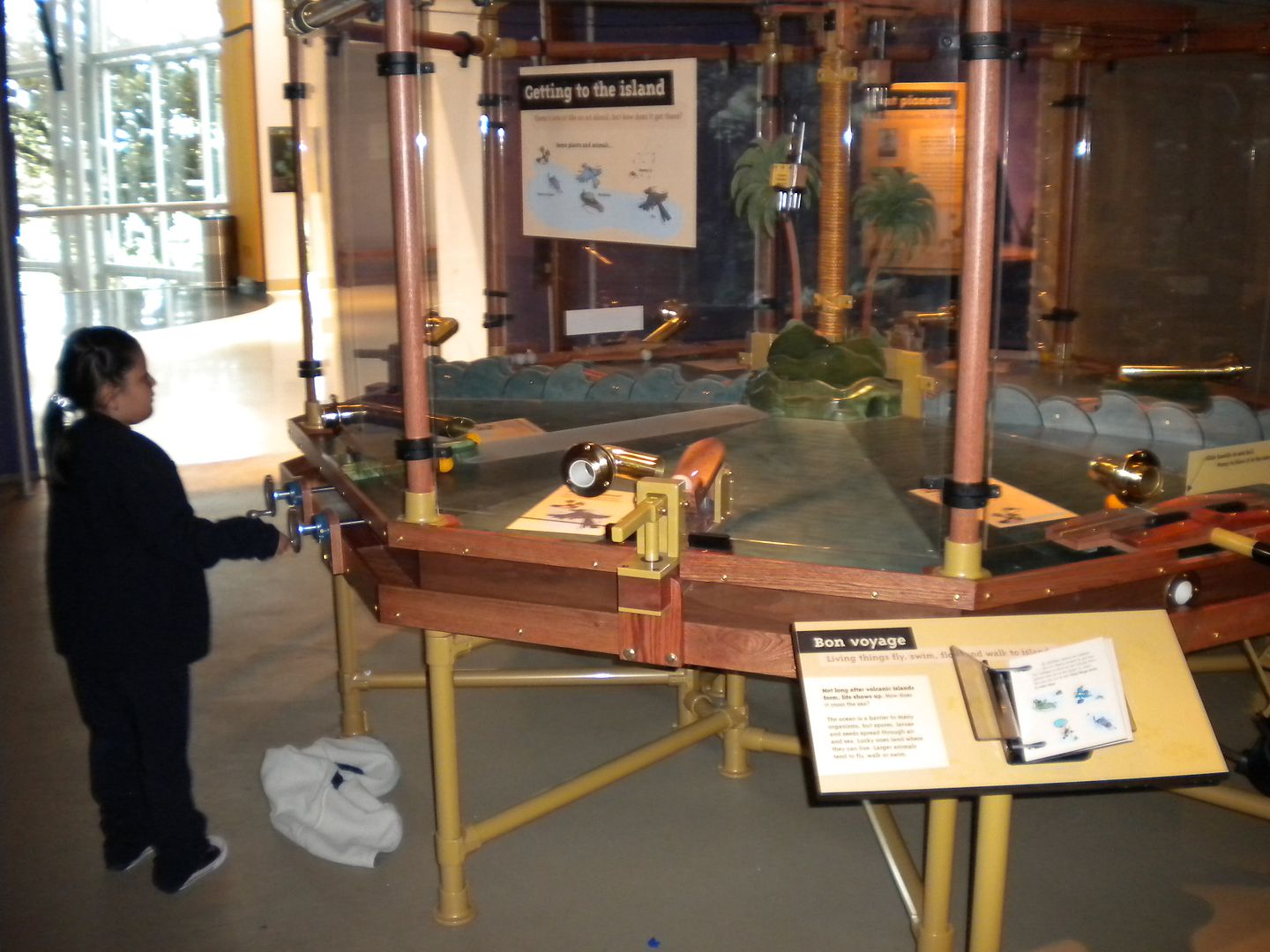
Tropical island ecosystem on display.
The ‘Extreme Zone’ includes radically different environments representing ecosystems — Rocky Shore, Poles, Deep Sea Vents, and the Desert, both pictured below. Environmental factors such as cold, droughts, and ice deeply test the limits of animals as they try to survive.

The peaceful desert ecosystem, moments before being assaulted with a once-per-hour flash flood to simulate life in the real desert.
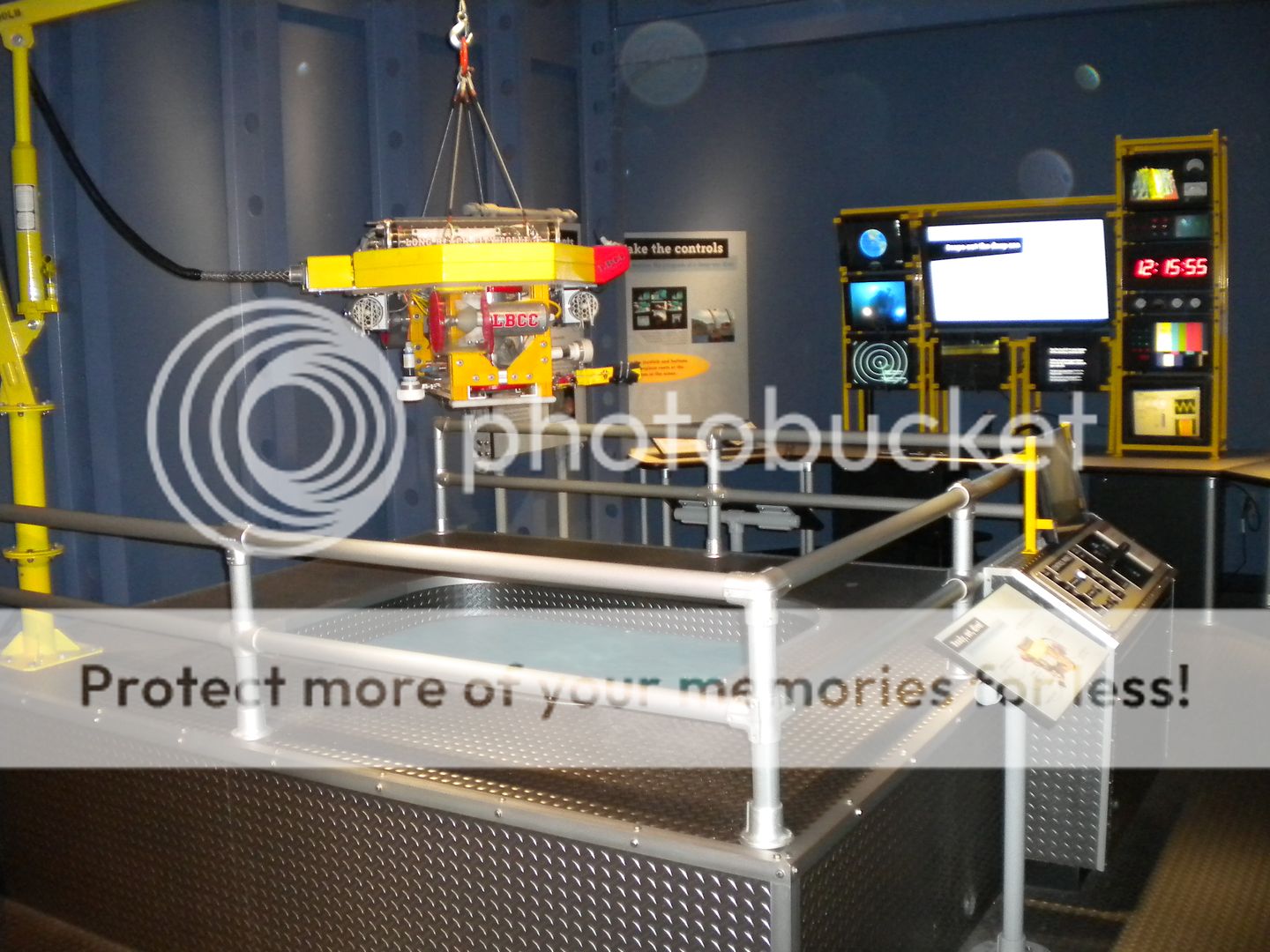
Deep sea vents, discovered only 30 years ago, spring from the process of chemosynthesis, with ambient temperatures as high as 760 degrees F. Visitors learn about how organisms have adapted to such a harsh climate by using the Earth's own internal heat to replace sunlight.
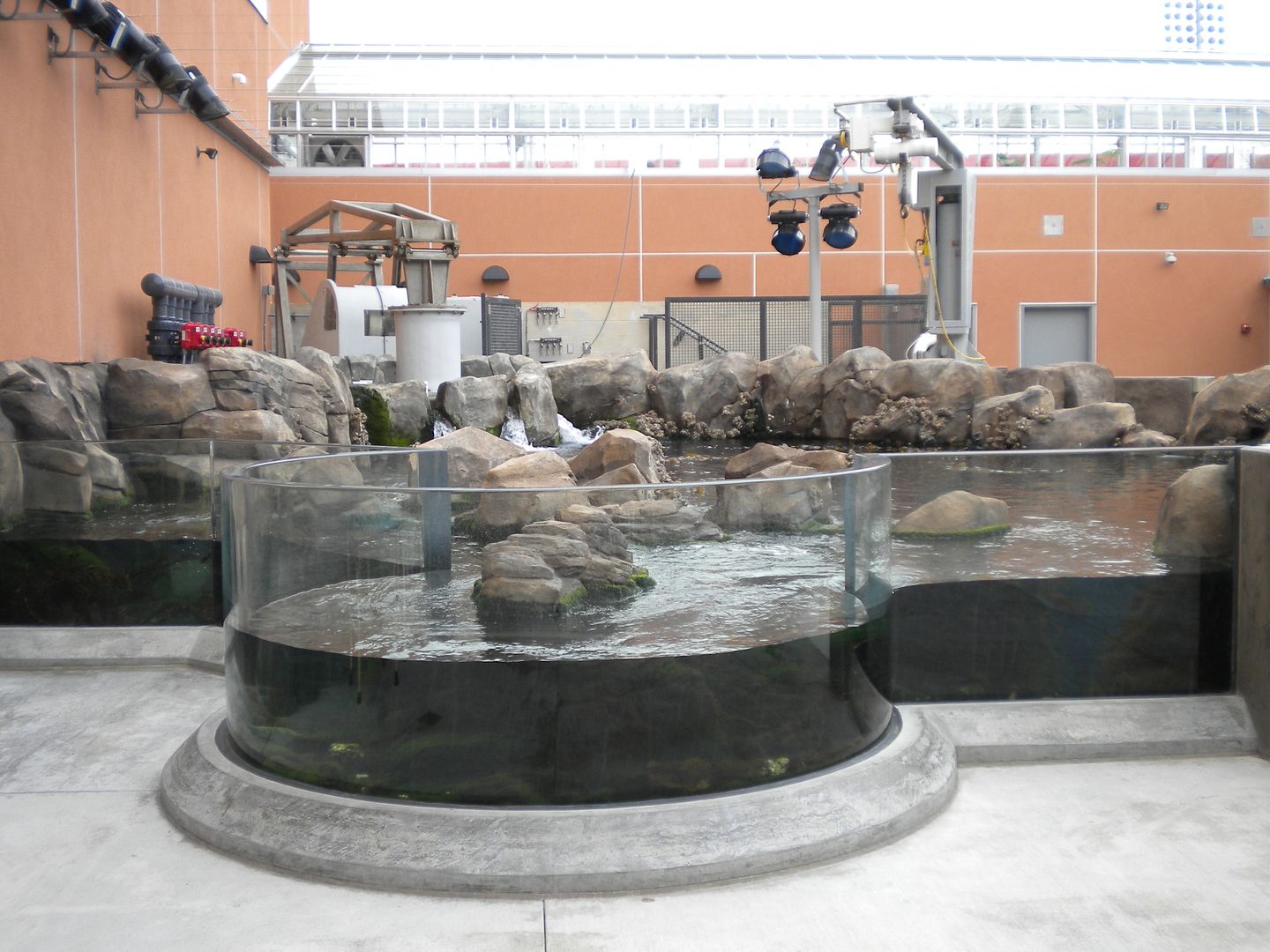
Sea life diversity on display at the outdoor tank.
The Global Zone allows visitors to travel around the world with an amazing, first-of-its-kind piece of technology: an internal projection high definition Magic Planet® exhibit, projecting images onto a global map from within the sphere to answer questions about matter and energy across the globe.
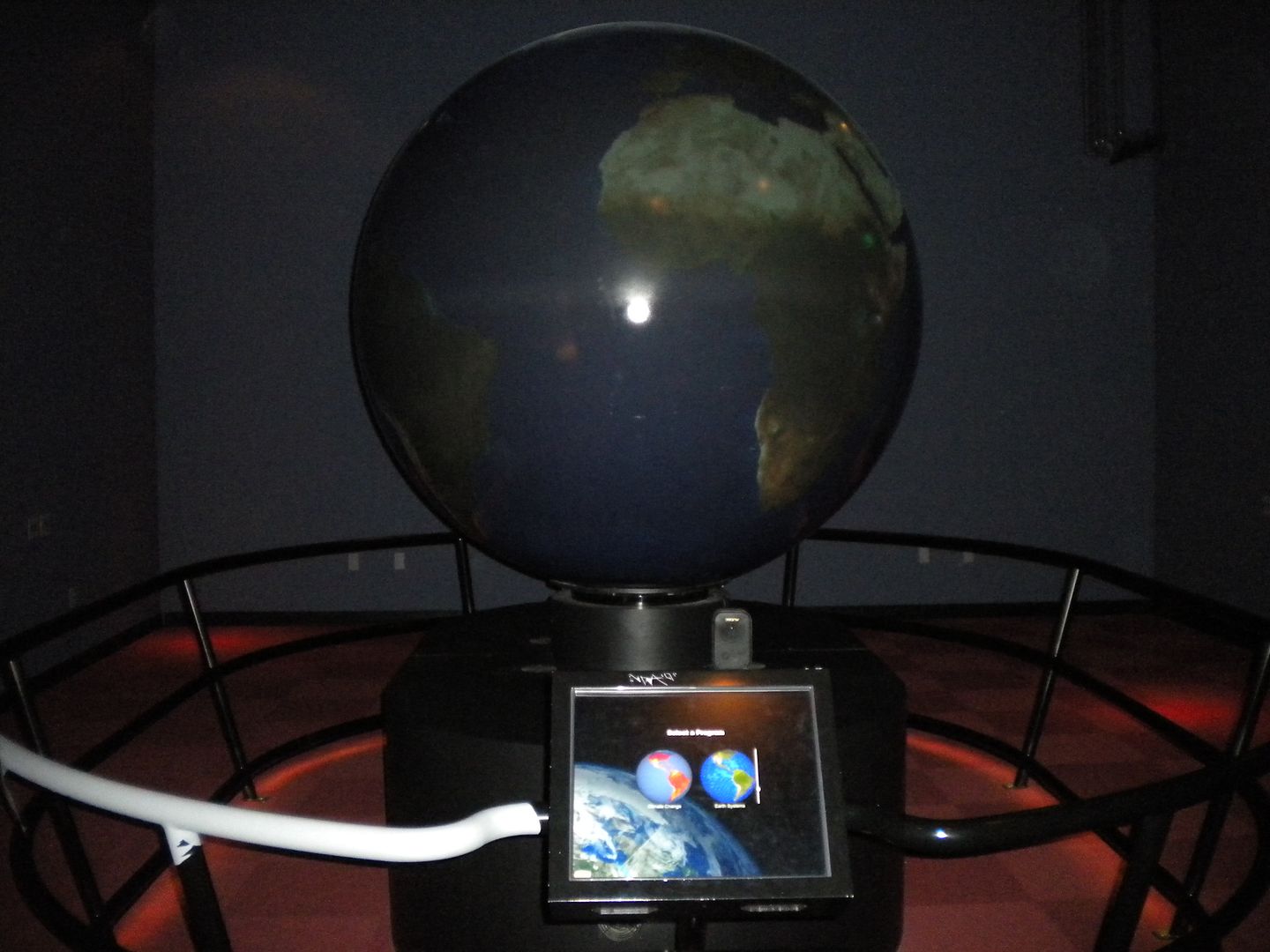
Darkened globe projecting information in the Global Zone.
One of the fan favorites of ‘Ecosystems’ is the ever-so-gross Rot Room, where folks can learn about how much the continuity of life depends upon, well… rot. Interactive decomposition exhibits (such as the one pictured below) and time-lapse videos show the recycling of nutrients and energy back into the environment.

Decomposition in action. Get the CSI experts in here!
The pièce de resistance of the California Science center’s ‘Ecosystems’ exhibit, and its biggest part by far, is the “Rain Forests of the Sea” exhibit, a 188,000 gallon kelp habitat — the largest man-made of any museum in the world — that illustrates the diversity of our sea forests and the environmental factors that kelp forests depend on: a rocky substrate, sunlight, moving water, and high nutrient levels.
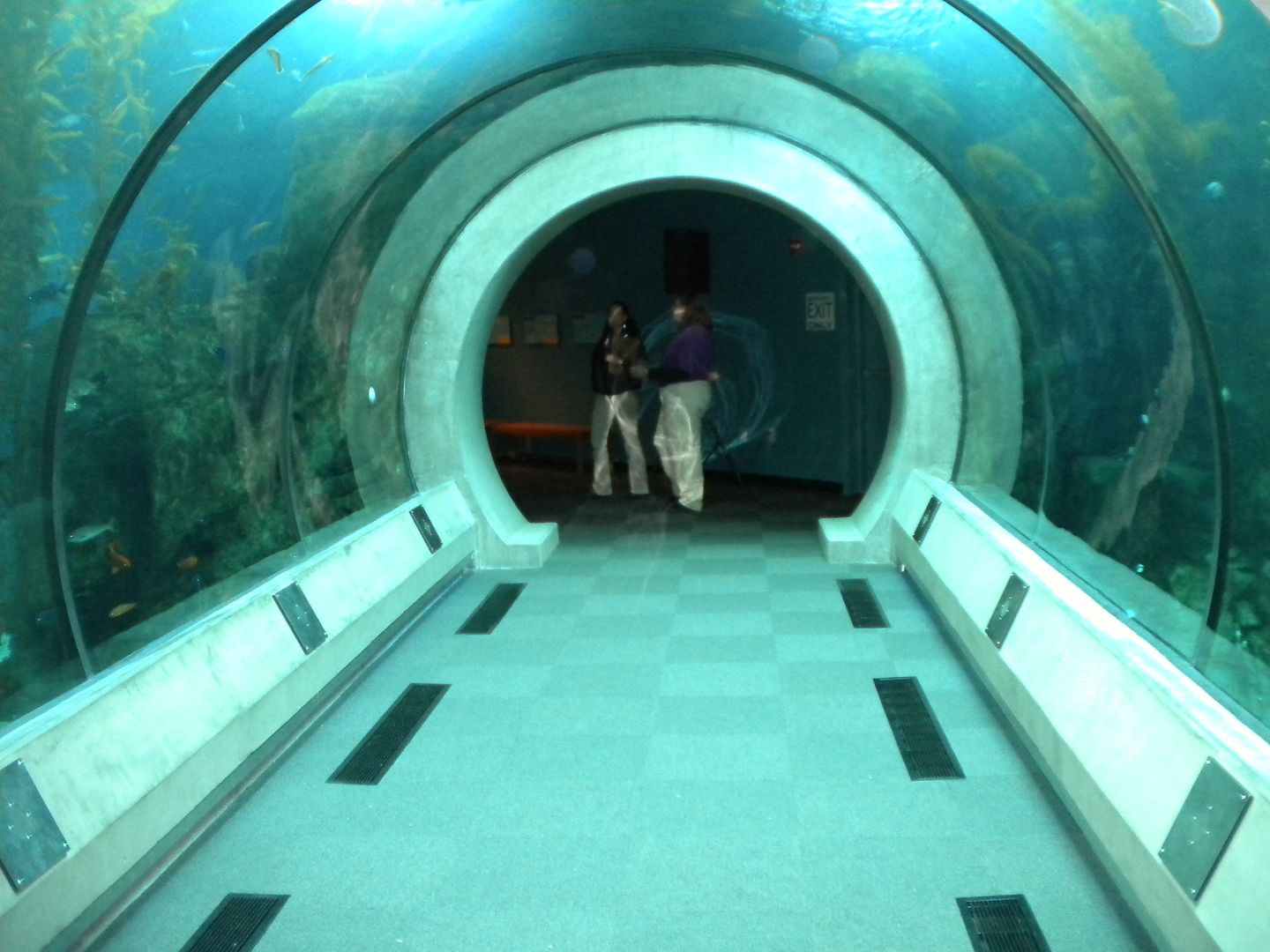
The kelp forest is accessed by the amazing 24-foot long transparent acrylic tunnel, displaying the life that exists in coastal kelp forests.
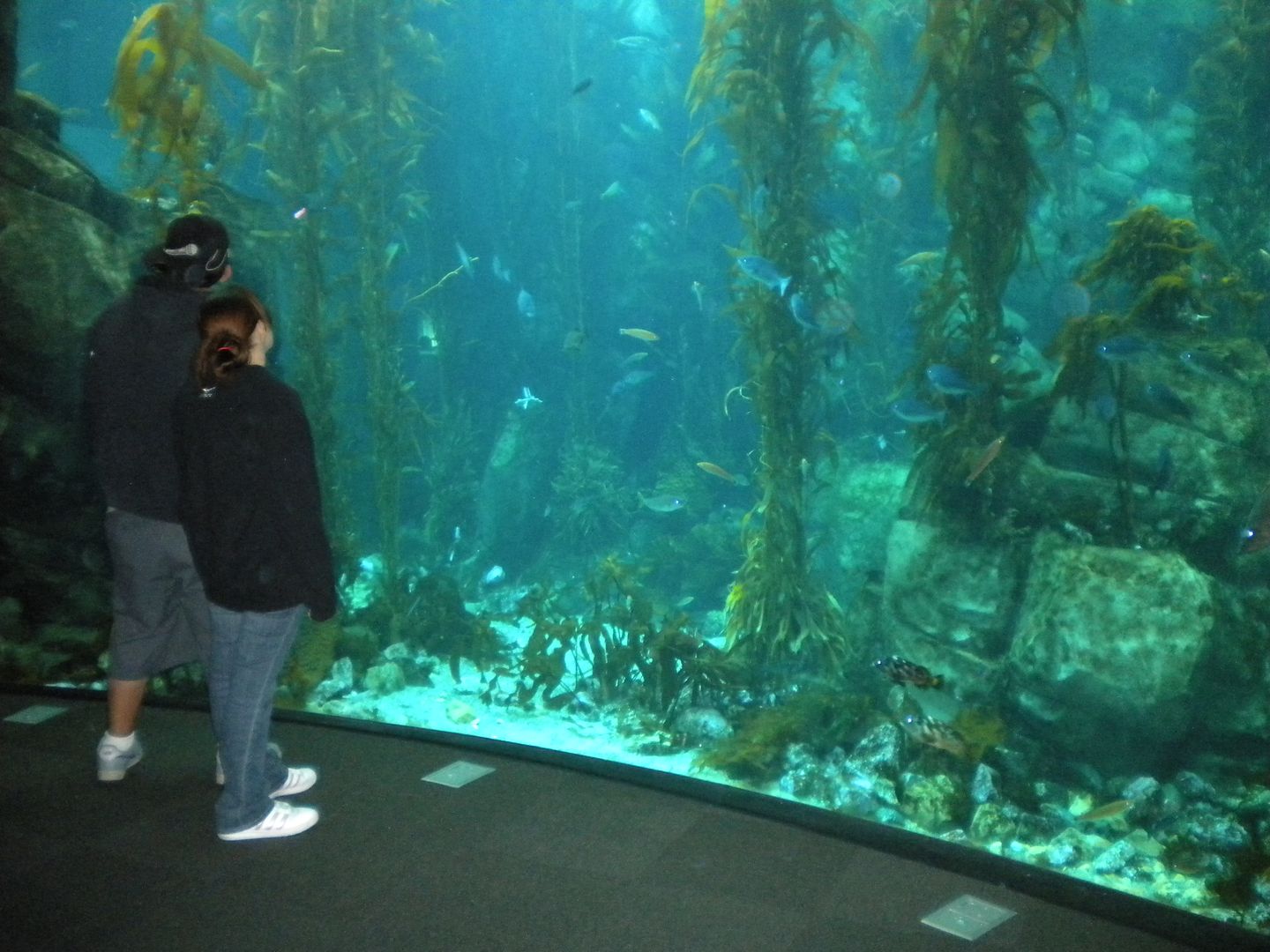
A close up of Kelp biodiversity includes more than 1,500 fish on display.
In the midst of the ‘Ecosystems’ exhibit is an interactive lab, where new additions to the over 250 species on exhibit at ‘Ecosystems’ are researched and cared for. In addition, it provides an opportunity for young high school students interested in pursuing science to answer guests’ questions, pursue research, and learn the scientific method in the process.
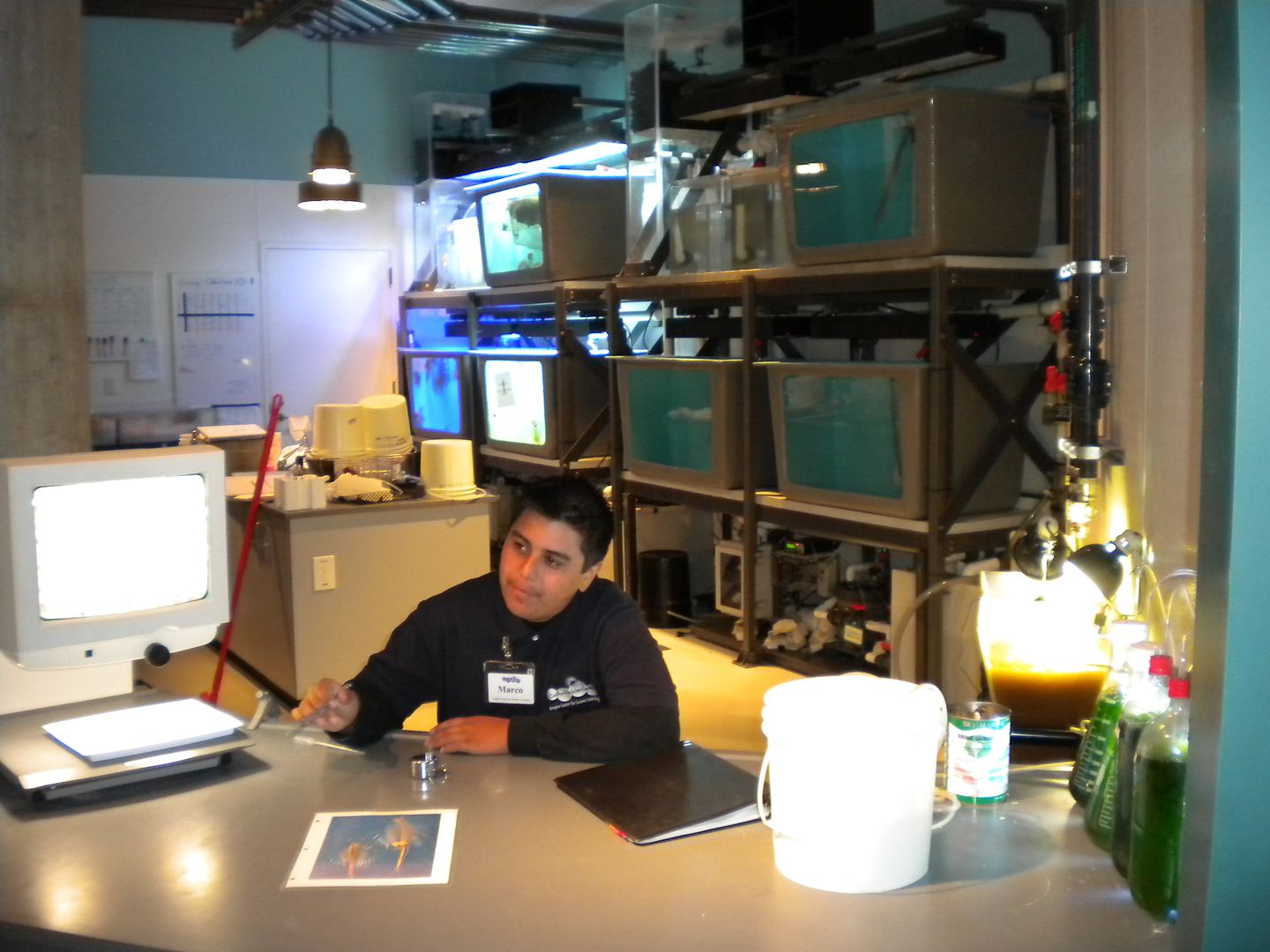
A young student working his internship in the official California Science Center 'Ecosystems' lab.
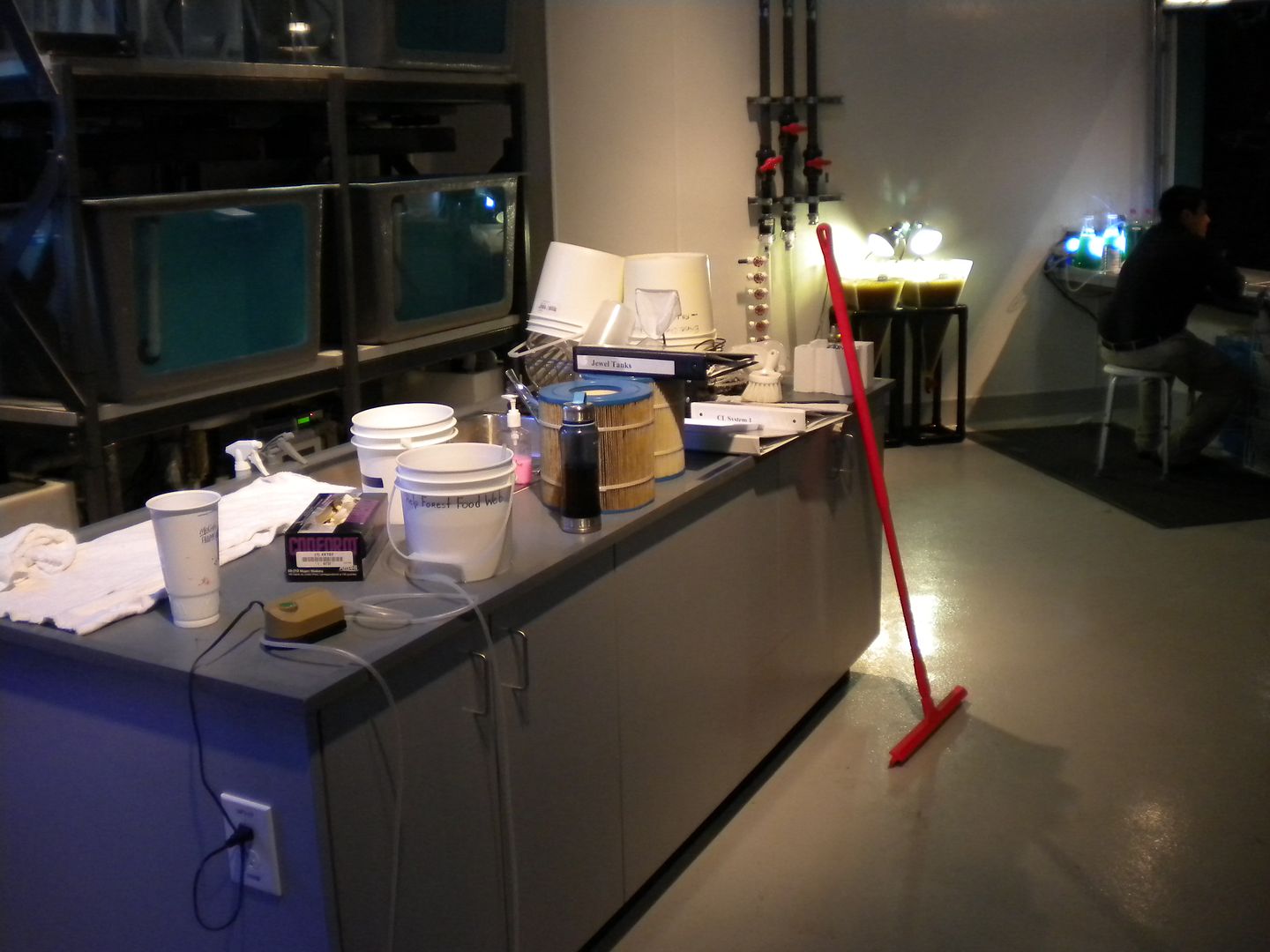
The hands-on lab allows permanent staff and scientists to maintain the exhibits, while young scientists have world-class facilities where they can pursue and cultivate their interests in research.
The end of the ‘Ecosystems’ exhibit takes visitors to the modern ‘L.A. Zone,’ where they can learn about weather patterns, wind currents, and geologic make-up of the Los Angeles Basin. Most importantly, visual waste exhibits expose the unique challenges in the issues of energy, water, and impact on wildlife.
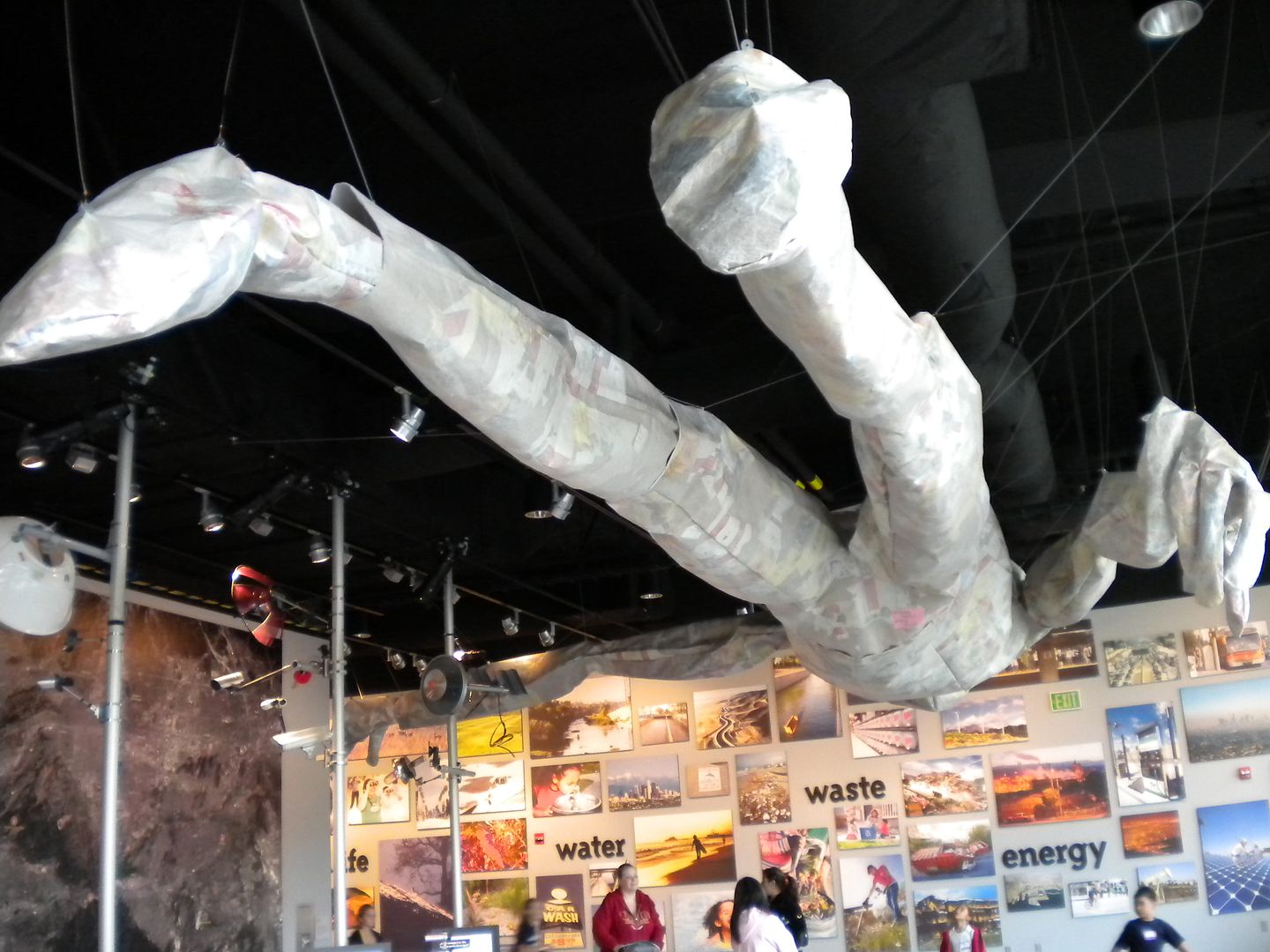
The California Science Center Paper Person. He was constructed of all the paper trash thrown away by patrons of the Science Center on Earth Day 2009. Yes, just on that day alone! The trash was washed, ironed, made into sheets, glued onto a felt backing, and covered with protective sheeting.

Ten years' worth of undecomposed waste, dug up from a California landfill. Newspaper headlines from the 1990s are still clearly readable.
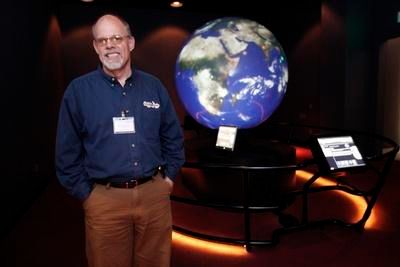
Dr. Chuck in the darkened "Global Zone" at the 'Ecosystems' exhibit in Los Angeles, CA. Photo courtesy of AP/Damian Dovarges.
The mastermind behind such wonders as the kelp zone (his sobriquet is indeed Dr. Kelp!), the Global Zone, and the Los Angeles Zone, among its other structural feats, Dr. Chuck Kopczak is as intellectually accomplished as he is full of wonder about science, our Earth, the environment and the best ways to teach children about them through technology and modern exhibits. Recently, he went on a collecting expedition in Guantanamo Bay, Cuba to study species and the environment. We spoke about putting together ‘Ecosystems,’ his hopes for it influencing the establishment of similar exhibits in science centers across the nation, and the larger overall goals of science education in America. Click ‘play’ to listen to our podcast:
Podcast interview with California Science Center’s Dr. Chuck Kopczak
ScriptPhD.com would like to thank the California Science Center, Dr. Chuck Kopczak, and Kristina Kurasz for their help and generosity of time. We encourage anyone planning a visit to Los Angeles, and interested in science and the environment, to check out this free exhibit and learning center.
~*ScriptPhD*~
*****************
ScriptPhD.com covers science and technology in entertainment, media and advertising. Hire our consulting company for creative content development.
Subscribe to free email notifications of new posts on our home page.
]]>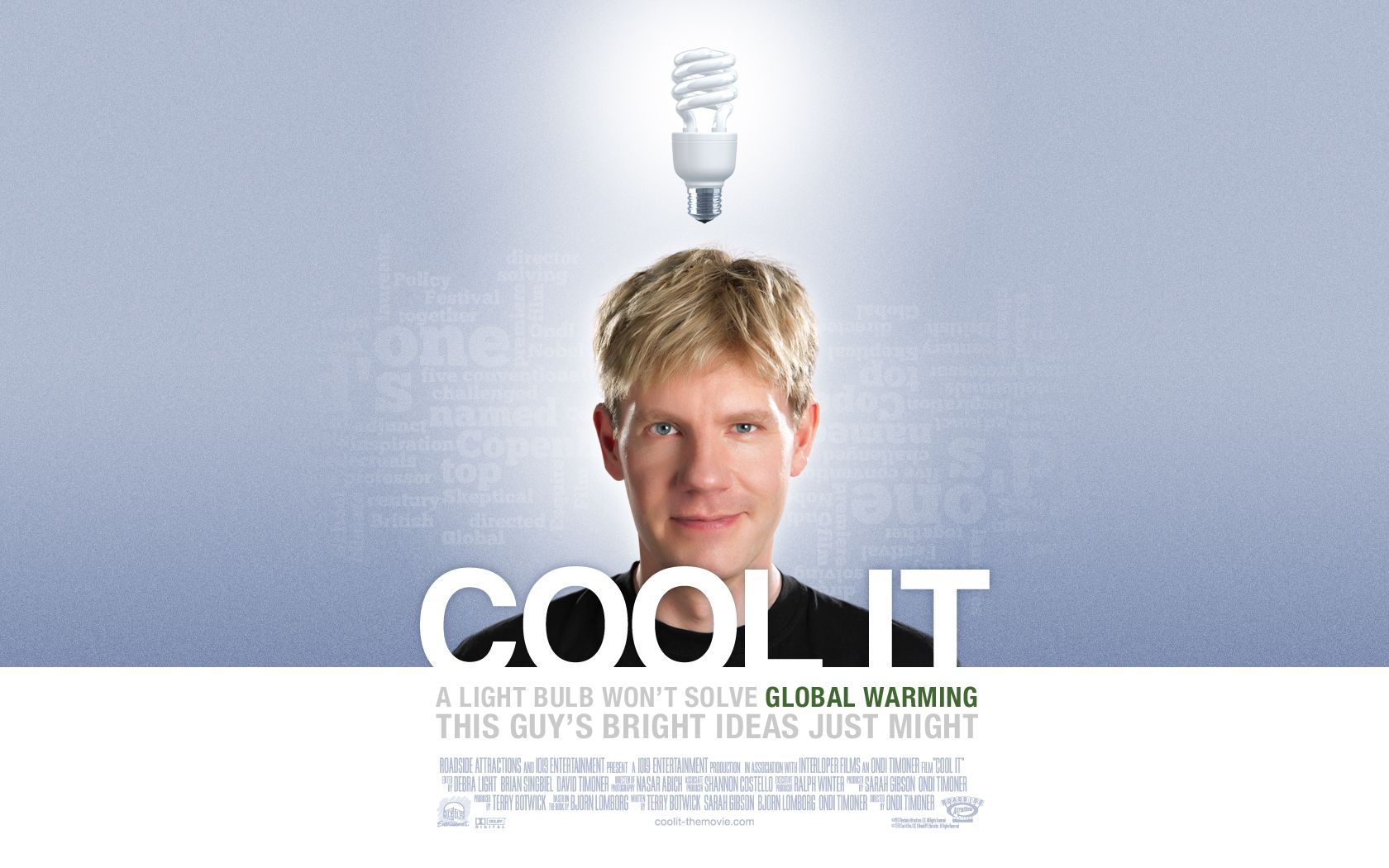
Cool It ©2010 Roadside Attractions, all rights reserved.
Fewer topics in contemporary science and technology policy have generated as much controversy or vociferous debate as global warming (more recently branded as climate change) and more importantly, how to mitigate its effects. Recent international treaties such as The Kyoto Protocol and conferences such as last December’s United Nations Climate Change Conference in Copenhagen have largely paid lip service towards actionable change and technology aimed at eradicating the precursors and causes of global warming. In the middle of this stalemate is an increasingly hostile rhetoric that has bifurcated into two divergent, unyielding camps—either you believe climate change and greenhouse emissions are a fraud, period, or you believe the problem is so imminently dire that surely, the end of the world is nigh. This dichotomy was no more apparent than during last year’s ”Climategate” controversy, in which hacked emails leaked from the University of East Anglia’s Climatic Research Unit in England were interpreted, depending on which report you read, as scientific fraud and tampering or reinforcement for climate science. Perhaps it is time, as the eponymous title of our latest Editor’s Choice suggests, for us all to Cool It. An environmental film about 21st Century problems, and the modern solutions they necessitate, Cool It presents an unapologetic, practical approach towards global warming and the problems that eclipse it. It’s time we all listened. ScriptPhD.com continues our ongoing “It’s Not Easy Being Green” series with a review of this thought-provoking, conversation-starting film. After seeing a recent screening in Los Angeles, we are proud to give Cool It our blog’s rare highest honor—Editor’s Choice. Join the conversation now under the “continue reading” cut.
A (Very) Brief History of Climate Change in Media and Entertainment
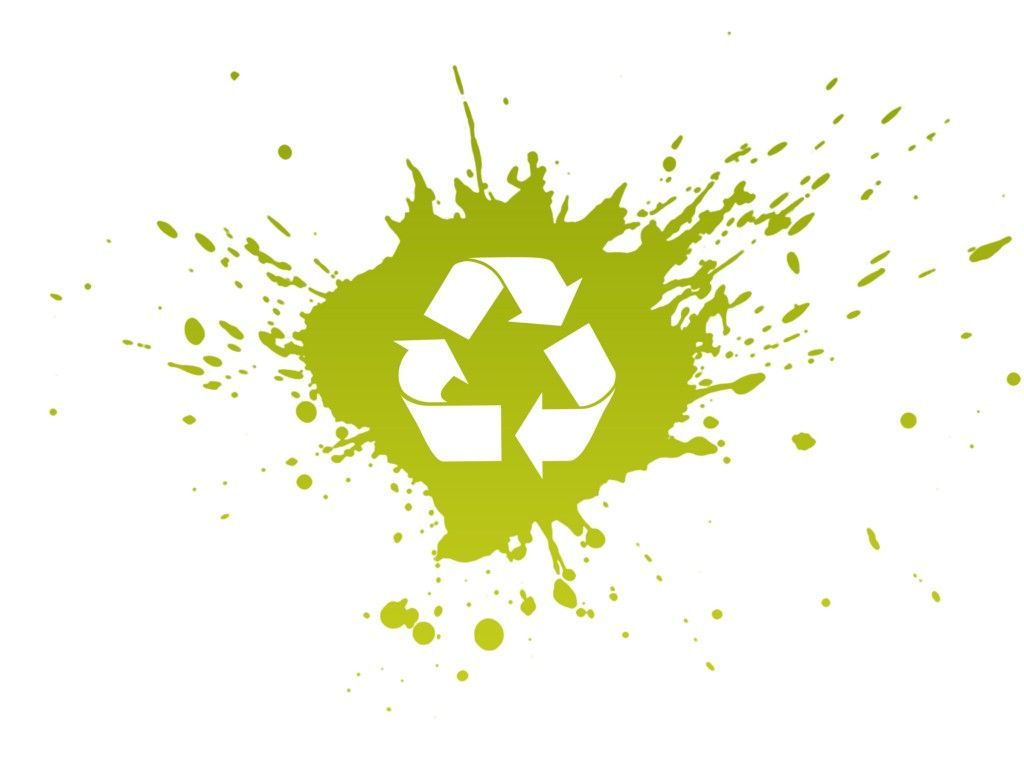
In 1896, Swedish chemist Svante Arrhenius made the first observation that fossil fuel combustion had a correlation to global warming. Discovery Channel has a terrific interactive on the history of scientific discovery in climate change here. It wasn’t until 1962, when a serialized novel called Silent Spring by Rachel Carson was published in The New Yorker magazine, that the issue took forefront in the public media. Considered one of the most influential works in the area of climate change, Silent Spring gives a meticulous account of how the pesticide DDT enters the food chain and accumulates in the fatty tissues of animals, including human beings, and causes cancer and genetic damage. Because of her book, President John F. Kennedy ordered his Science Advisory Committee to look into the book’s claims (use of DDT has since been banned, much to the consternation of bedbug sufferers everywhere!). President Nixon went on to pass the Clean Air Act and create the Environmental Protection Agency, which now has the power to regulate harmful greenhouse gas emissions. Another major milestone for climate change in modern media was the 2006 release of Al Gore’s Oscar-winning film An Inconvenient Truth, which has been given credit not only for re-energizing the environmental movement, but for raising the profile of global warming. (Cool It has been referred to as an “anti-Inconvenient Truth,” but we’ll get to that in a moment.) Marketing and advertising are never far behind the cultural zeitgeist, as green branding has been one of the most successfully growing sectors in the industry. An article in Advertising Age in April of 2010 listed the 10 Green Marketing Milestones of our time.
Who is Bjørn Lomborg and Why is He So Controversial?
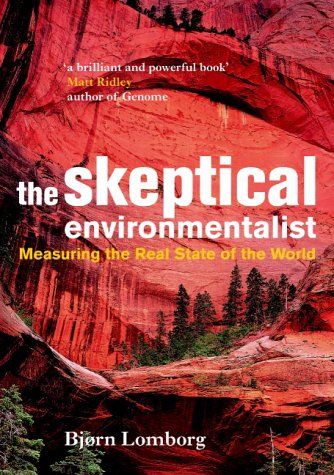
The Skeptical Environmentalist
In 2001, a then-unknown adjunct professor at the Copenhagen Business school named Bjørn Lomborg published a book called The Skeptical Environmentalist, which claimed that not only were some of the more dire claims of pending environmental catastrophe exaggerated, but that they were flat-out wrong. Though a carefully-researched volume, the central thesis of Environmentalist was anathema to the academic climate community, and caused an immediate hailstorm on both sides of the climate change spectrum. Accusations of scientific dishonesty, one of the most austere charges within academia, were brought forth by several environmental scientists to the Danish Committees on Scientific Dishonesty. Their finding was mixed, ruling that The Skeptical Environmentalist was scientifically dishonest, but absolving Lomborg himself due to his “lack of expertise” in the field. The decision was later annulled by the Ministry of Science, Technology and Innovation, citing a lack of proof and specific standards. Lomborg has remained a polarizing, contentious figure ever since.
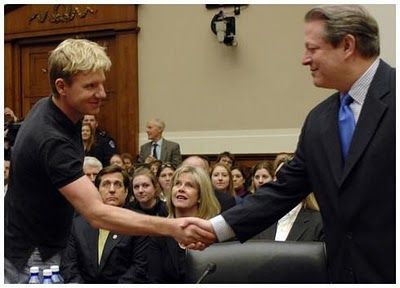
An Inconvenient Handshake: Bjorn Lomborg greeting Al Gore at the Copenhagen Climate Conference.
Lomborg, since named one of the 100 most influential people by Time magazine, is now the director of the Copenhagen Consensus Center, where he brings together some of the world’s top economists, including five Nobel laureates, to brainstorm how to solve the world’s most pressing problems. He followed up his first book with another eco-centered piece, Cool It, that offers an alternative platform for the trillions of dollars of current funding aimed at counteracting (often ineffectively) the effects and sources of global warming. In no way denying the very real phenomenon of climate change, Cool It is instead a polemic on contemporary global problems that merit our action and attention right now and that, if solved, will simultaneously obviate climate effects as a bonus. With the help of Director Ondi Timoner, Lomborg has translated Cool It into an extremely interesting, thought-provoking and entertaining documentary. ScriptPhD.com got a sneak peek in Hollywood a couple of weeks ago.
REVIEW: Cool It
ScriptPhD GRADE: A
“Fear has been ruling the climate debate,” declares Lomborg in the opening minutes of Cool It, proclaiming what is a sort of mantra for this film. Fear sells. Fear opens eyes. Fear declares attention. (Read our piece on The Science of Fear.) But fear drowns out messages in hyperbole and bombast. Far from decrying the looming reality of climate change and global warming, Lomborg is simply suggesting that it isn’t the impending catastrophe that media and scientists have ingrained us to believe. Fueling these misconceptions, Lomborg believes, are popular culture messages and movies that simply exaggerate claims, and do nothing to add to a productive conversation about global warming. Take a look, for example, at the opening film shown at the United Nations Climate Change Conference 2009 (COP15) in Copenhagen from the Ministry of Foreign Affairs of Denmark and decide for yourselves if its hyperbolic, fear-fueled message is more about solutions or rhetoric:
This, a commercial for planestupid.com that attempts to correlate airplane emissions to extinction of polar bears:
Turns out that the Kyoto Protocol, if enacted to its full potential, would only save one polar bear per year lost to the effects of global warming. This does nothing to ameliorate a far bigger problem—we shoot 300-500 polar bears to death every year!
“When is something fashionable and when is it rational?” Lomborg asks us. In 2010, hundreds of millions of people participated in Earth Hour, a collective global undertaking to turn off our lights for an hour. Many of the participants undoubtedly lit candles instead, which unfortunately emit twice the CO2 emissions of a light bulb! The 20 trillion in proposed global funding, even if appropriated, will only result in a 0.1 ºF temperature effect by the end of the century. Cap and trade, the Kyoto Protocol and even this past year’s Copenhagen conference, Lomborg asserts, are a waste of time and money that perpetuate decades-old failed promises. Furthermore, the only way for poor countries to climb out of penury and into first-world status is by burning coal and consuming energy. It’s simply unrealistic to think otherwise. The problems that keep Lomborg up at night—AIDS, malaria, disease, lack of access to clean drinking water—are far more important to third world countries than global warming. Nothing illustrates the schism in priorities better than the juxtaposition of two classroom scenes, one in rural Africa and one in urban England. In each case, Lomborg asks the students what their priorities are, what they wish for and what frightens them. To a one, the African students wish for basic luxuries that we take for granted, such as a house and a car, with most rating their top priority as health care. The British students, warm, safe, comfortable, and fed, worried mostly about global warming and our planet’s demise, drawing pictures and describing scenarios that would make Edgar Allan Poe cower in a fetal position.
The second-half of Cool It, far from harboring anti-climate change beliefs, largely focuses on the science and technology advances that must occur to a) counteract global warming, b) make energy, and especially alternative energy, cheaper and c) solve some practical problems in the meantime. Solar panels, for example, are still ten times more expensive than fossil fuels, while unsightly and space-hungry wind turbines face a “not in my backyard” backlash from communities. Revolutionary advances such as energy garnered from water-splitting (read ScriptPhD.com’s recent article on this very phenomenon at The National Ignition Facility), and artificial photosynthesis present amazing potential to create unlimited sources of cheap energy. Lomborg interviews former Microsoft CTO, scientist Nathan Myrvold, whose idea machine includes inventions such as a nuclear energy reactor fueled by waste at a cost competitive to coal. Clearly in awe of scientists, Lomborg touches on adaptation—the notion that global warming, and certain inconveniences thereof, will impact humanity, but that we can counteract these effects through smart technology. The Dutch, 60% of whom live below the sea level, experienced a far more devastating flooding than Hurricane Katrina in 1953, and have since erected the world’s best levees. Urban cooling, such as painting all rooftops white, would impact temperatures in global warming hotspots such as Los Angeles as much as 5 ºC at a one-time cost of $1 billion. He also touches on possibilities within the highly-contested field of geo-engineering, to date largely considered a sci-fi concept, wherein global warming is literally reversed with science. Cloud brightening to reflect more solar light into space and cool the planet, volcano mimics in the stratosphere for the same purpose, experiments to literally suck the CO2 out of the air, regenerative grazing for raising farm animals—all hold immense promise for future generations.
To be sure, Cool It has an agenda, inasmuch as An Inconvenient Truth, or any other subjective work espousing a decided point of view. At ScriptPhD.com, it is not our position to wholly agree or disagree with either position, but rather to applaud the ideas they represent, and to continue a dialogue that will eventually lead to solutions. “No matter what I found over the next year,” said filmmaker Ondi Timoner of undertaking this endeavor with Lomborg, “It was worth taking on this project to see if perhaps I could create a film that would help push through the polarizing logjam that had become the never-ending (and extremely expensive) climate debate towards real and practical solutions.” It’s time to face the facts that changing one light bulb or driving one Prius, no matter how well-meant, simply isn’t going to change the world alone. It’s time to also admit that the contentious, argumentative, ineffective stale-mate that has become the climate debate is serving no one, least of all the worst-off populations needing clean water, health care and technology. Over-exaggerated, frightening tales might sell movies and commercials, but they don’t get bills passed, and they don’t apportion funds for smart, permanent solutions and scientific advancement. Love him or hate him, but Lomborg is 100% on-point in that regard. Whatever side of the climate change debate you fall on, we guarantee that seeing this film will make you rethink certain positions and priorities, while reinforcing the immutable, inescapable fact that we simply must invest in alternative energy technologies and the scientists that are revolutionizing them. Concluded Timoner: “We all breathe the same air, and we all need to unite to focus on the right priorities at this crucial tipping point.”
Let’s start a real conversation today. We welcome any and all comments and reactions as you see the film, or on this topic in general.
Cool It goes into selected release in major cities on November 12, 2010. View a list of cities and release dates here.
Cool It trailer:
~*ScriptPhD*~
*****************
ScriptPhD.com covers science and technology in entertainment, media and advertising. Hire our consulting company for creative content development.
Subscribe to free email notifications of new posts on our home page.
]]>
Wind turbines collecting energy that will eventually be converted into electricity and other fuel sources. This technology is widely discussed in the new Discovery Channel special "Powering The Future." Image courtesy of Discovery Channel.
Nothing has done more to reinvigorate discussions about energy and fuel dependence than the tragic oil spill currently afflicting the Gulf Coast [excellent resource for trajectory, timeline and news sources]. Though scientists and oil manufacturers continue to debate the validity of the “Peak Oil” theory, a very uncomfortable reality looms that oil production may not be able to keep up with thirsty demand. With an ever-increasing global population, a constant proliferation of technology choices and lifestyle improvements, and a rising middle class in third world countries, the factors contributing to fuel consumption may be the precipice of an eventual geopolitical crisis. In an effort to showcase their dedication to addressing the most salient energy and environmental questions affecting our generation, the Discovery Channel, backed by founder John Hendricks, is launching a revolutionary four-part documentary called Powering The Future. In it, they address a range of economics, national security, social and scientific questions related to energy and fuel all through the single focal point of searching for a modern, clean, limitless supply of energy. Our coverage of Powering the Future includes a review of the first installment and an exclusive podcast interview with the show’s host, lead scientist for the Nature Conservancy, Dr. M. Sanjayan. For full content, please click “continue reading.”
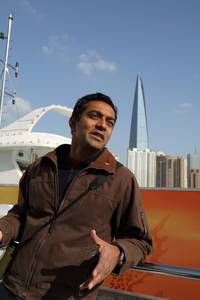
Dr. M. Sanjayan, host of Powering The Future, and lead scientist at The Nature Conservancy.
“We are the energy generation, but we as Americans do not
fundamentally understand what energy is, where it comes from, how we use it, and how much we need,” remarks Dr. M. Sanjayan, host of the new Discovery Channel four-part documentary Powering The Future. Indeed, any honest retrospective of the modern energy crisis first requires a primer reviewing how our dependence on major fuel sources (coal, oil, and natural gas) came about and the unique challenges that breaking it poses. I consider myself a fairly well-informed individual, particularly on scientific matters, but in watching the first installment, The Energy Revolution, even I was amazed at the sheer interconnectedness of major electrical grids, and how much links us globally in energy delivery vessels. A German electrical engineer in the documentary compares running a major grid to being an air traffic controller.
Much of the current hope for alternative energy sources rests in grandiose ‘silver bullet’ solutions. Scientists at the National Ignition Facility are using the world’s biggest and highest powered lasers as a power source for smashing together the hydrogen atoms in a droplet of water, resulting in nuclear fusion. This mimics the way that the sun makes energy, and, if successful, would harness a limitless supply of power. Nuclear fusion research has been ongoing since the 1940s, but has never been applied successfully on a large enough scale like the undergoing experiments at the Ignition Facility. [ScriptPhD.com was recently granted an exclusive tour of the Ignition Facility, which will be covered soon in a separate post.] Another growing ‘silver bullet’ sector has been the harnessing of two natural energy sources—the sun and wind. Wind energy is the largest (and fastest-growing) alternative source of energy. Denmark gets about 20% of its power from wind sources, while the United States gets approximately 1.2%. Photovoltaic, or solar panels, more mobile and aesthetically pleasing than wind turbines, are another popular source of alternative energy. Little money has been poured into researching photovoltaic grids as a large-scale source of energy, it holds promise. The 89 petawatts of sun that shines on the Earth each year is more than 6,000 times the 15 terawatts of electrical power consumed by human. Unfortunately, both of these energy sources face one insurmountable hurdle; their mercurial natures. Our modern lifestyles require a constant influx of power, but if the sun stops shining, or the wind stops blowing, solar and wind technologies are unreliable.
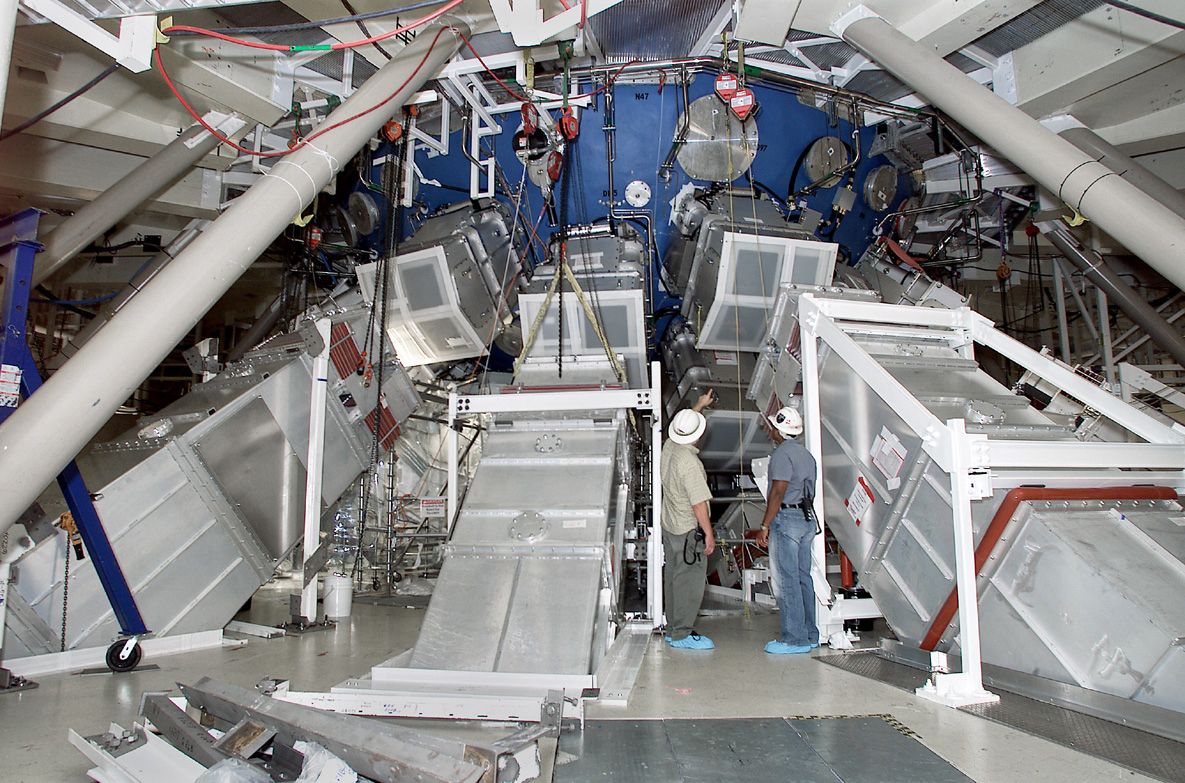
Scientists make adjustments to the enormous lasers at the National Ignition Facility in Livermore, CA.
The reality is that moving energy consumption into the 21st Century will not happen with one grand discovery, but a microcosm of intermediary ones. Powering The Future provides some exciting insight into the body of research and creativity being applied to alternative energy sources. Many communities are powering themselves through clever solutions, such as Japan generating solar energy in outer space and then beaming it to Earth, or New York City harnessing wind energy from tidal waves in the East River. No role is rendered more important in this documentary than that of private organizations and academia in leading innovation and discovery. Bay Area-based Makani Power specializes in capturing and storing high-altitude wind for abundant power and energy. Caltech University solar electrochemist Dr. Nate Lewis has invented a thin coating of paint containing chemicals that catalyze the sun’s energy for power. Paint your roof, get free solar energy! In fact, just today, General Electric announced a $200 million smart grid contest for cleaner and more efficient electrical grids. The California-based X-Prize Foundation has even gotten in on the act, recently announcing a $10 million oil spill cleanup challenge.
Even those that consider themselves knowledgeable about environmental issues and research and technology of clean energy will have a lot to learn from Powering The Future. The special does an exceptional job of laying out the complex science behind concepts such as fusion and large-scale electrical grids for a lay audience to understand, while not glossing over current research in industry and academia. Moreover, rather than approaching the issue with the typical heavy-laden, moribund fatalism one often finds in these specials, Powering The Future leaves one feeling hopeful about the range of innovation happening at all levels worldwide, and the remarkable commitment of both academic labs and private companies for tireless discovery. It is this very entrepreneurial, resilient, and utterly human, attitude that will power our future more than any fossil fuel ever could.
Powering The Future premieres on the Discovery Channel on Saturday, July 17, 2010 at 8 PM ET/PT.
Finally, we encourage you to listen to our exclusive one-on-one podcast interview with Dr. M. Sanjayan (18:00), lead scientist of the Nature Conservancy, as we expand the energy discussion of the mini-series to global solutions, his thoughts on the oil spill crisis, and ways that we can impact our dependence on fuels right now.
~*ScriptPhD*~
*****************
ScriptPhD.com covers science and technology in entertainment, media and advertising. Hire our consulting company for creative content development.
Subscribe to free email notifications of new posts on our home page.
]]>
Happy Earth Day, 2010!
Here at ScriptPhD.com, we pride ourselves on being different, and we like thinking outside the mold. So for Earth Day 2010, we wanted to give you an article and a perspective that you wouldn’t get anywhere else. There is no doubt that we were all bombarded today with messages to be greener, to use less, to be more eco-conscious, and to respect our Earth. But what is the underlying effect of advertising that collectively promotes The Green Brand? And has the Green Brand started to overshadow the very evil—environmental devastation—it was meant to fight to begin with? What impact does this have on the future of the Green movement and the advertising agencies and media that are its vocal advocates? These are questions we are interested in answering. So when we recently met Matthew Phillips, a Los Angeles-based writer, social media and branding expert, and the founder of a new urban microliving movement called Threshing, we were delighted to give him center stage for Earth Day to offer his insights. What results is an intelligent, esoteric and thoughtful article entitled “Plastic Beads and Sugar Water,” sure to make you re-evaluate everything you thought you knew about going green. We welcome you to contribute to (and continue) the lively conversation in the comments section.
“Access to land provides access to food, clothing, and shelter—which means access to land provides the possibility of self-sufficiency—if anyone wants to maintain a dependent (and therefore somewhat dependable) workforce, it’s crucial for you to sever their access to land. It’s also crucial that you destroy wild foodstocks: why would I buy salmon from the grocery store if I could catch my dinner from the river? Now, with people having been effectively denied access to free food, clothing, and shelter, which means having been effectively denied access to self-sufficiency, if they are going to eat, they’re gong to have to buy their food, which means they’re going to have to go to work to get the cash to buy what they need to survive. If you’re a corporation, you’ve got them where you want them.” —What We Leave Behind.

Native Americans practiced and perfected an eco-sustainable culture on land long before it was dotted with wind turbines.
I have a great deal of admiration for our original permaculture engineers, the American Indians, all grass fed bison advocates. Looking back, we can’t imagine how naive or gullible they were to accept fire, water, plastic beads and useless trinkets in exchange for their healthy animals, fresh fruits and vegetables, consulting knowledge, and land—whose value is incalculable. Interestingly, here we are 518 years later, and we’ve all been duped into giving up our valuables for well marketed sugar water, and filtered tap… in plastic bottles.
After 1492 the American colonization effort was dominated by the European nations. In the 19th century alone, 50 million people left Europe for the Americas with ‘old world’ diseases, and a manifesto to massacre, obliterating 42 million American Indians. Everything changed; the landscape, population, plant and animal life. A few pioneers with rebel attitudes proved they could kill, conquer, and dominate an entire people and their land. What have we learned? When you deprive a group of people access to their land, you dominate and control their self-sufficiency, and ultimately their sustainability.
Earth Day was designed from its inception, April 22, 1970, to inspire awareness and appreciation for the Earth’s environment. Like all successful grassroots movements, Earth Day continues to self-organize and experiences annual growth. Over the years, it has propagated thousands of related causes or brands. This celebration gives us the opportunity to contemplate how to purchase food and drink that are produced locally through natural, sustainable methods. Whether we graze together, or barbecue grass-fed bison, I anticipate that many foodborne conversations will thresh organic ideas that seed new urban backyard businesses, and energize sustainable causes.

Green living appeals, such as this one from GreenMaps, have proliferated greatly in our culture over the last few years.
In fact, in this past year, we have witnessed local production and sustainable social causes grab the wheel from the generic “Green” brand. ‘Local and sustainable’ terms have the potential to drive significant impact in helping redefine a movement whose banding terminology is arguably out-of-focus. The Green goal has not achieved our Garden of Eden fantasy. Many generic Green causes have become distracted watching, and often joining, the fight against their ‘evil,’ instead of cultivating community and encouraging positive purposeful action. We’ve seen new Green causes sprout through PR dusting designed to crowd out similar already established causes. There’s nothing wrong with competition, seeking a bigger audience, news, press, and ultimately funding, but often the next new Green cause articulates greater Green evils in an attempt to further establish its reason to rally. This problem is churned up further with traditional reports broadcasting emotionally charged sound bites. Reporters often don’t take the effort to dig past the easy emotional approach, and into the rich cream of the cause itself. It is much easier to philosophize about the negative, which can feed our illusion of intellectual superiority, but it’s really keeping our callus-free hands from getting dirty planting GM-free maze in the garden and producing oxygen. “The creation of something new is not accomplished by the intellect but by the play instinct acting from inner necessity. The creative mind plays with the objects it loves,” said Carl Jung.
A great brand seeks to unify in a cyclical system: Magnetizing believers, educating, generating action, and finally producing evangelists, who then magnetize new believers and so on. Memorable brands are most effective when they are communicating their power and concept through story. At its most basic, a brand’s story is made up of the hero, (relating to the brand’s reputation and hopefully positive recognition), and its evil, (the perception of what hinders recognition of the brand). Clarifying the adversaries of the brand can help to ‘rally the troops,’ codifying their cause and movement. Without an adversary, it’s often difficult to get enough of a rouse from fellow partners to get anything started.

Green brands, and the agencies that brand them, can all learn from Google.
Every great brand needs an evil to fight, but Green’s evil has metastasized into the most unimaginable catastrophe that no cause could ever compete against—an over heating planet. Since it doesn’t get much worse than a gooey globe due to our ongoing abuse, this heat enemy seemed guaranteed to become THE unifying force, an evil that we could all fight together to overcome. The problem is the scope is too large to control or confine. It has mutated. Proving global warming has the potential to fracture the green community, and along the way has produced a number of serious critics. Terms like ‘climategate,’ and climate skeptics like Doug Keenan, continue to look at research they say is embellished to promote climate change. Maybe worshiping the over heating demon has made the ‘Green’ brand seem boring compared to the excitement of the fight. Google never defined its “Don’t be Evil,” last minute tag, which is part of the reason it continues to generate conversations across the board. Google has essentially allowed all of us to insert our own definitions of evil, which in effect has unified greater numbers to their brand. A very novel approach.
If the evil of a brand consistently gains more press than the cause, then the evil assumes and replicates the identity of the brand. When this happens, the brand is no longer the host. When the evil forcefully sucks all the nourishment from the brand’s beating heart, then the evil we were fighting becomes the cause. We feel more comfortable with our fingers on the keyboard dealing intellectually with evil, which in effect, removes our foot from the shovel of physical, sweaty action. Do we want to get back to the heart of the brand, the original cause? Harley Davidson, once perceived as the brand of choice for rebels and tattooed ex-cons, re-branded itself and become the hog of choice for everyone who could scrape together enough money, regardless of prison experience, body type, tattoo placement, or gender. Even our kids wear official HD branded fashion with pride.
If we stop promoting the evils, real or manufactured, and start encouraging positive actions and solutions, (often positive action is the best offense against perceived evil anyway) we’ll find passionate people that want to join us in healing our people and planet. The strategic approach to refresh a brand is extremely important if it is to succeed. Digitally empowered consumers want to punish those that don’t behave in a socially responsible way and reward those that do. Social media has given people real power to act, and also to be negative. “Social media is inherently more negative than a positive medium on many levels,” said David Jones, the global chief executive of Havas Worldwide. “Lots of stuff that is passed around is negative. If you are a brand or a company today you should be far less worried about broadcast regulations than digitally empowered consumers.”
Many will continue to base their directive on creating new enemies, using ‘the fight’ to impassion those around them to rally their cause. Stop depleting the ozone layer, reduce your carbon footprint, global warming. All grand Green, but terminology that is technically fear-focused. We’ve heard the pitch: “It is your investment of $59.95 that allows us to partner together to fight this injustice.” The fear based, negative approach is almost always wrong, (unfortunately, it can be effective) . It’s a slippery slope, and those who don’t fully embrace the creed, are either stamped ‘stupid,’ or ostracized. But sustainability should be positive at its core. There is a time to debate, and we’ve debated ourselves into the greatest recession any of us have ever experienced. It’s time to stop debating.

Farmers markets in local rural and urban environments are an excellent example of community organization and positive cohesive sustainability action.
Let’s begin by forming communities that build sustainable ventures together. If we are fighting, or politicking, we are not building. “We have become divided into so-called red and blue states, an outcome directly traceable to the urban-rural division of our society. This is something of a simplification, but food producers and their social allies tend to vote red and food consumers and their social allies tend to vote blue. The division is thought to be between conservative and liberal philosophies, but it much more reflects the difference between rural and urban values,” said Gene Logsdon.
There are two real challenges within the sustainability movement:
1) Consumers’ decisions (especially with food) are splintered by: A) Convenience, B) Tradition, C) Bias, and D) Beliefs.
2) Industry’s “manufactured demand” is affecting consumers with: A) Deceptive advertising, B) Ambiguous terminology, C) Perfectly designed plastic convenience packaging sealing our addictive lifestyles.
The minute we wake up we are subjected to an eco-plastic, part of this complete breakfast, 100% edible, industrialized high fructose corn syrup, brand campaign. Industrialized conveyor belts are pumping out a marketing product of starch coated with refined sugar. We can reignite our camaraderie by producing fruits, vegetables, animals and vehicles that not only compete, but surpass, our current available choices; all sponsored of course by our very green desire for sustainability. Incidentally, the average number of ‘green’ products per store almost doubled between 2007 and 2008. Green advertising almost tripled between 2006 and 2008. Does this necessarily mean we are heading in the right direction?
Governmental regulations for consumer protection in industrial food processing plants have only added to an already over stressed food system. This industrialized hyper-efficiency has caused diseases in animals and bugs on crops that have been taken so far out of their natural ecosystem that they can no longer produce without heavy use of antibiotics and pesticides. These measures, of course, were designed to keep us safe, but instead have become another major concern since “packaged nourishment” comes from the industrialized, often treated, food system.

The Jungle, by Upton Sinclair, is largely considered to be the first creative activist endeavor within the food production industry. Its revelations of horrors and regulatory failures in Chicago's meatpacking plants resulted in direct laws that govern food processing in the United States to this day.
Creatives are beginning to find and tell the stories concerning the overly subsidized and industrialized food and distribution system which favors use of pesticides and antibiotics. Since the government historically is not very good at spearheading movements, artists (media pioneers, authors) and social entrepreneurs will continue to fill this leadership role. We don’t have to look far to see powerful results. Thank the documentary filmmakers of Food Inc., Supersize Me, HomeGrown, The Future of Food, Story of Stuff, and Bottled Water, for helping us become visually aware of how industries have been deceiving consumers and themselves in their interest of greed and everyone’s desire for convenience. But there is hope, and it’s simple. Consumers are communicating online like never before, this leads to uniting together to strategically direct where we spend our hard earned bread and where we plant or raise our own food.
Jamie Oliver’s new TV series, The Food Revolution, has exposed the frozen fat underbelly of pre-packaged (brown and gold) foods, and government charts that officially dictate the clogging of our kids in school. Local and “real” food production and consumption has become a legitimate genre, with universities, and high schools requiring reading of titles like Barbara Kingsolver’s Animal, Vegetable, Miracle, Michael Pollan’s Omnivore’s Dilemma, Bill McKibben’s Deep Economy, among others. These authors are helping us move past intellectual reasoning and into action. Since Timothy Ferrass taught us how to achieve a four hour work week, some of us among the fortunate now have the extra time to plant some seeds, water, and grow great big vegetables, and share them with our friends and neighbors.
I believe that in the next decade we will see less of an emphasis on extrinsic, materialistic values and more on intrinsic, spiritual values. This shift in emphasis will begin to bear fruit with the collaborative grafting between creative media pioneers and social entrepreneurs who seek to disrupt the status-quo. Research from San Francisco State University has shown that experiences bring people more happiness than material possessions. Experiences shared with others continue to provide even greater happiness through memories long after the event occurred. I believe many social entrepreneurs and creative media pioneers, in their hearts, believe their core purpose is to encourage our return to a sustainable world ecosystem. In other words, many will forgo Hummer-sized riches in order to nurture the successful adoption of their creations into society. There remains however ambiguity in the complexity that lies between the producer and the consumer. The ancient system of distribution gives middlemen the leverage to manipulate both producers and consumers. This too is evolving, as producers return to their roots and begin to distribute locally. There is change in the air, spring is coming.
We are at such a nascent stage in the evolution of the sustainable movement. The infrastructure necessary for the modern city to relocate to the farm is exorbitant, but the farm is beginning to integrate into the metropolis, one yard at a time. ‘Off the grid’ produces many wonderful connotations. It is an adventurous subject, one that I’m convinced will help propel this branding conversation forward. I wonder who else is discussing the connections of the ideas from this article, and from the authors and media pioneers mentioned? Who are the artisans, and social entrepreneurs that are working on this? Very curious about your thoughts. Please don’t hesitate to email me, and please act.
Let’s continue to find new ways to unify this brand with wonderful heart felt stories about the adventures of locally produced products, urban farms, and sustainability.
Writing this has given me a renewed appreciation for early American Indian cave drawn stories of food: adventure, and victory. There is more there than I had imagined.
Matthew Phillips is a media producer, writer and technologist working in Los Angeles, CA. He is the producer of Threshing.
*****************
ScriptPhD.com covers science and technology in entertainment, media and advertising. Hire our consulting company for creative content development.
Follow us on Twitter and our Facebook fan page. Subscribe to free email notifications of new posts on our home page.
]]>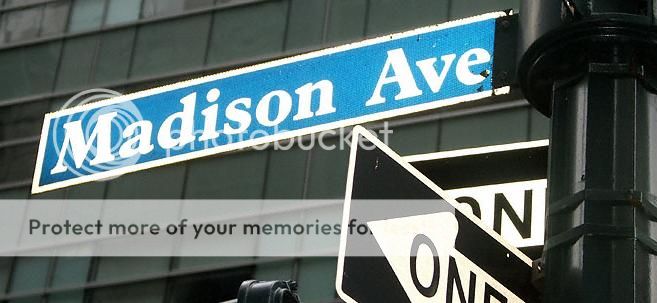
Much of today’s messaging about the environment, green initiatives and ways for the public to make a difference physically and fiscally are centered around media and advertising. To wit—even amid the deepening recession, one market has seemed to defy the economic downturn: green and environmentally-friendly product launches. Sadly, however, a large and growing subset of the eco-conscious creative collective is enveloped in hyperbole and hubris, a term the industry has labeled “greenwashing” that we will discuss in much greater detail in another article. It was natural then, that as part of our Earth Week coverage, ScriptPhD.com undertook green advertising as part of our continuing “Selling Science Smartly” series. Here, we profile a case study of several impressive (and effective) campaigns by the West Coast-based RIESTER, including work on recycling, clean air, and the first fully-integrated municipal sustainability campaign in the US. We also had an opportunity to speak with RIESTER’s executive team, who provided insights into their creative strategy, why green advertising is more challenging than ever before, the crucial importance that interactive played in their success, and why every agency should be blogging more.
Campaigns: CalRecycle’s “Bottles and Cans” and STAND FOR LESS campaigns; Maricopa County’s Clean Air Make More Campaign (print, television, interactive)
Agency: RIESTER (Los Angeles, Phoenix, Salt Lake City)
Industry: Environment, Sustainability
If it seems like RIESTER is ideally suited to forge new ground in environmental advertising, they are. As a self-described ensemble of “brand activists,” RIESTER has taken on important social, health, technology and sustainability causes that transcend any individual campaigns or creative material. They’ve woven impact into the fabric of their 20-year identity to become one of the largest independent advertising and public relations firms in the United States. Their “Great Salt River” cleanup campaign resulted in one of the greatest single-day volunteer turn-ups in American history. A mid-90s shocking anti-tobacco campaign was so successful in curbing teen tobacco consumption, that it garnered the attention of major national media outlets. Likewise, their campaign with Gold’s Gym partnered with the American Diabetes Association, and gym members, to fight America’s growing obesity problem. Having written extensively about the environment on their blog, RIESTER has shown dedication and commitment to impacting real change with meaningful, long-term work. Here are several of their recent efforts.
A clever, funny spot devoted to clean air awareness in Maricopa County, Arizona (notoriously fraught with pollution and smog problems):
In 2009, San Diego became the first city in America to initiate a fully-integrated sustainability marketing campaign to encourage citizens to use less energy, water and vehicle mileage and to recycle more. Here are a series of television spots for the San Diego STAND FOR LESS Campaign:
And finally, an exceptionally smart, unusual ad for the California Department of Conservation touting the value of recycling from a most different perspective:
Why we like it:
Plain and simple, these campaigns are different. RIESTER has managed to tap into a creative channel that reaches its audience in a new, clever, sly way. When was the last time you saw a commercial or billboard about recycling that anthropomorphized the object being recycled? The answer is probably never. More than likely, the spot you saw showcased sad pictures of yet another ravaged, pillaged section of our fraying Earth, or graphics touting the benefits your behavior has to our environment. This spot takes those arguments, and flips them 180 degrees. It’s cute, it’s funny, and that bottle has some kind of attitude! The result? Since the campaign’s launch, California increased their recycling rates by 16%. Likewise for the Maricopa County clean air spot. Arizonans are constantly bombarded with appeals and rations stave off pollution problems. This commercial is flat-out ridiculous… and ingenious. Even in Beijing, one of the most consistently over-polluted cities in the world, people don’t walk around holding their breath from one location to the next. But the spot is positing an over-exaggerated situation to have people imagine a time when we would have to do such an unthinkable thing, and in turn, to drive them towards actions that would prevent it.
Why it’s good green advertising:
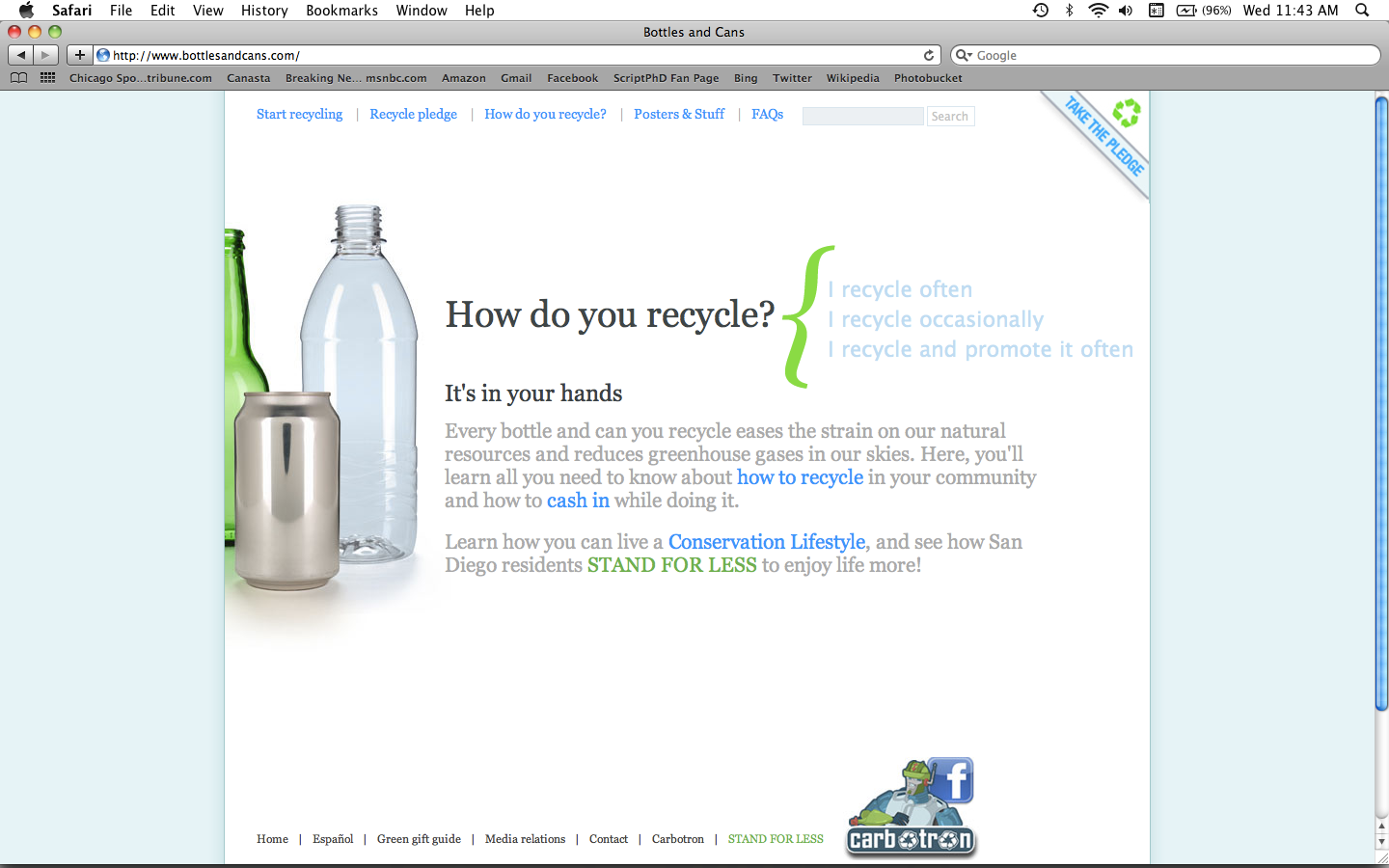
The CalRecycle website engages with its audience interactively, providing a platform for change.
Nobody likes being told what to do. Any parent of a 2-year-old toddler can attest to this. And no one likes being guilted into doing something. Neither is a strong motivation for long-term behavioral change. Where RIESTER veers smartly from this staid formula is in fully engaging with their audience on a nonjudgemental level. Crushing and recycling a can, something that can hardly be compared to the equivalent of, say, buying a Prius, becomes significant to them. Take a look at the CalRecycle website pictured on the left. It asks rather than tells, and it includes all participants of recycling, even those who never recycle. That’s significant. Too many environmental initiatives fall into the trap of preaching to the choir, never reaching a new target audience that hasn’t been exposed to the message. Here, an interactive campaign groups you togehter, whether you’re a granola-eating, hemp-clad, lean mean green machine, or you have never even thought about recycling before. Engaging the entire community together, and providing them with the necessary know-how for sustainable behavior, is the only functional long-term solution.
Why it works:
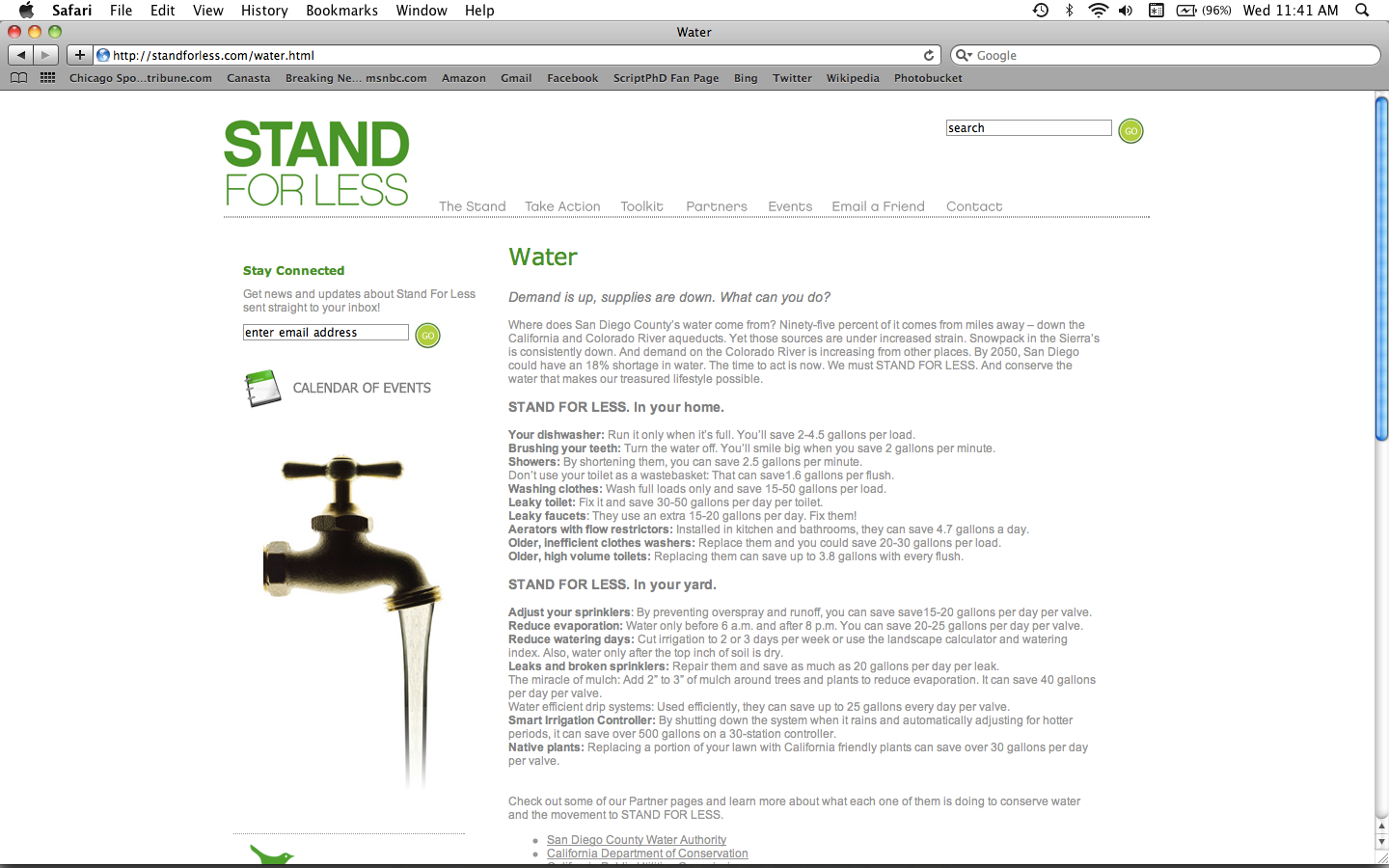
The STAND FOR LESS website and blog.
RIESTER’s green campaigns, especially STAND FOR LESS, are truly interactive, and go a long way towards continuing long-term conversations about community sustainability. The advertising spots are really just the start of the conversation. For this, the STAND FOR LESS campaign was the rightful recipient of a 2010 Addy Award for an integrated campaign. The STAND FOR LESS site features a blog with a constant news stream, a calendar of events to get involved, a toolkit for individual activists who want to get involved, and informative content on ways to incorporate eco-conscious behavior into one’s own household. They take advantage of social media in a meaningful way, with both Facebook and Twiter feeds for people to exchange ideas. Research has clearly shown that simply providing people with information, especially in single doses, has little effect on individuals and businesses. Instead, a community-based model of social marketing has emerged to encourage sustainability practices. STAND FOR LESS is an important start in what will eventually be a common model of urban initiative.
What other green science campaigns can learn from this one…
In selling green science smartly, don’t recycle ideas, pardon the pun. Be edgy, different, and think outside the box. A recent Gallup poll (released April 09, 2010), revealed that green behavior in the United States, although common, is not changing. Standard eco-friendly practices such as recycling, low-wattage light bulb replacement and purchasing decisions, have either increased marginally or not at all since 2000, when green advertising began bombarding the airwaves. Furthermore, there is an enormous collective guilt over the ideal we know we should be achieving, yet consistently fall short of. Advertising that feels sanctimonious will only reverberate this effect, rather than motivating people into significant change. When many people either don’t know where to start or feel overburdened by incorporating yet another lifestyle change into an already overscheduled and busy day, it’s important (as the STAND FOR LESS campaign does) to remind them that small, inexpensive actions incur an additive effect and do make a difference. The use of humor, irony and droll, tongue-in-cheek moments, like imagining how good recycling must feel for the bottle, are far more effective in sparking and retaining dynamic conversation than either direct information or ham-handed appeals. Getting people’s attention like this is especially critical in the face of an onslaught of green noise in labeling and product availability, many of which are under no obligation to prove their claims. Indeed, the New York times noted that as of 2008, the advertising industry was significantly pulling back on eco-friendly marketing due to growing public skepticism of ads with environmental messages. The take home lesson is that agencies will simply have to work harder and smarter than back in the days when we were all a little green about being green.
ScriptPhD.com caught up with RIESTER Executive Creative Director Tom Ortega and Editorial Director Jim Breitinger to talk about their conservation work, the thought process fueling their smart “green” creative, why interactive is imperative, and what makes for good environment advertising in our cluttered, hyper-messaged media.
ScriptPhD: RIESTER proudly proclaims themselves as a collective of “brand activists.” Can you shed a bit more light on your definition of “brand activist” and how that influences your creative philosophy when it comes to science, technology and particularly sustainability advertising?
Tom Ortega: RIESTER has a long history of working with clients who have a purpose beyond commercialism, which is the statement that you see on our website. What that means is that our clients do much more than serve an immediate need for a consumer. So while we do a lot of work for [non-sustainable] products, we’ve found other connection points as well with the consumer so that the consumer can develop a longer-lasting relationship with those brands. The idea of becoming activists has two sides to it as well, because we feel that when consumers become true believers in a brand, they themselves become activists for those brands. And their voice is certainly greater than any voice that can be heard. We all know the power of the word of mouth, right? That’s what we’re able to create, whether it is for a pure sustainability campaign, or a packaged good product that really connects with the consumer.
Jim Breitinger: The term is also an organic outgrowth of, really, who we are, the kind of business we go after, and the clients we have. We become incredibly passionate about who they are and what their cause or product is. We’re the activists who go the extra mile for the client.
SPhD: So much of impacting pro-environment and sustainability efforts involves changing behavior and wielding persuasion. Ironically enough, this is exactly what advertising is in the business of doing. In your minds, have agencies been underutilizing the power of social marketing and what are some of the areas you’d like to see it expanded, both in content and risk-taking.
TO: Agencies, over the past five years, have become very smart about human behavior, and recognizing how brands connect with that behavior. What you’ve seen over the past years has been a growth of research and planning involved in advertising campaigns. So I don’t know if it’s been underutilized. What makes RIESTER different is that we have an in-house planning department that has researchers who are working here every day who understand social change, human behavior, why people do things—whether it has to do with recycling or buying a specific product. For us, behavior change is something that we take very seriously, it leads most of our campaigns when it comes to research and developing a foundation for the campaign.
Part of what’s tricky about advertising in the “green” arena is the word “green,” which has certainly lost its meaning. This is due to the greenwashing that has occurred throughout the past number of years. It reminds me a lot of the nutritional advertising that was done years ago with all of the blanketed “fat free” nutritional messages that were put out there. I think environmental marketing runs the risk of neutralizing itself with messages that really aren’t relevant or really don’t have meaning them. It’s important to understand that consumers are smart, consumers are worn out and getting message fatigue, and we have to make sure that this message has meaning behind it. When we’re telling people a certain product or behavior has sustainable practices, it darned well better fit that bill.
SPhD: As is the case for many science and technology ads, there is a tendency for environment, social awareness and sustainability messages to be anodyne or milquetoast. One of the things I love about your California recycling campaigns (video and print) as well as the Maricopa County Clean Air campaign is the use of humor and irony. Very clever stuff! Take us through some of the creative strategy for these spots and how you hoped to get the messages across.
TO: Well, human beings want to be entertained. We owe it to them, if we’re going to take up thirty seconds of their time, to entertain them to a certain degree. Because if we don’t, they’re not going to pay attention to the message. So it’s important for us to create a message they’ll want to watch. Humor is a great way to do that. It’s also a wonderful way of breaking down barriers that might already be there. The idea of air pollution is sort of a hackneyed idea. We’ve been hearing it over and over again for years, and you have to get people to pay attention to that message, to demonstrate that it is relevant to their lives.
For the California recycling campaign, “Good For the Bottle, Good For the Can,” it was funny because in California, people really understand, they get it. It’s the original environmental state. But in order to get deeper with it, we had to commit it a lot differently, and not just state that it’s good for the planet. That message has already reached the target that cares about that. We had to reach a different target, and talk about the fact that it was good for these cans and bottles, and sort of personify these as beings that would go on to live another life. You have to get people to look at things differently—that’s part of behavior change.
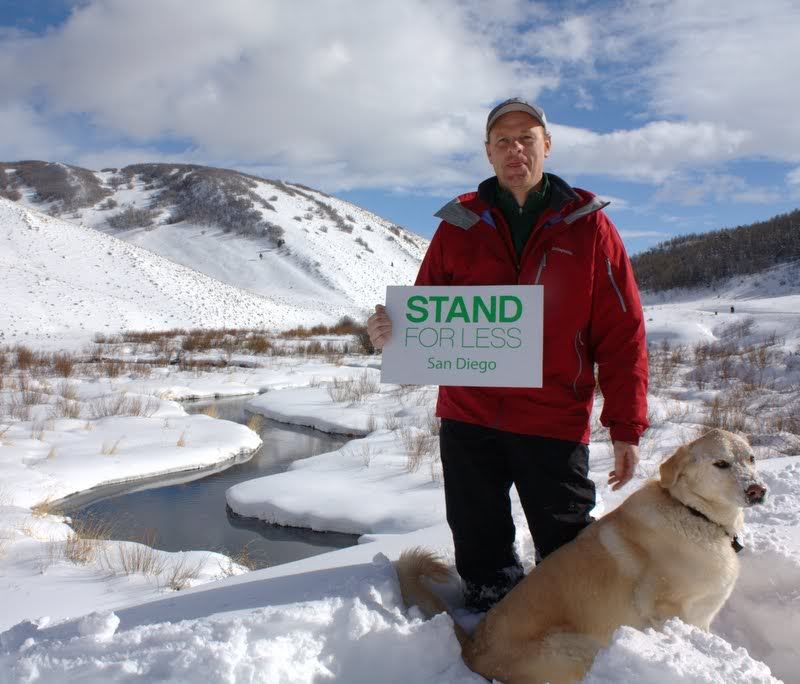
RIESTER Editorial Director Jim Breitinger stands for less in the mountains with his dog.
SPhD: Let’s spend some time talking about the impressive STAND FOR LESS campaign. When you have a city approach you about a wide-scale campaign like this, what are some of the first things that go into laying down a foundation, or groundwork for the overall message?
TO: The most important part of that campaign was to organize the coalition of members, the people and partners to this, and that was really spearheaded by Mirja Reister, our executive planner. She worked tirelessly to bring together partners from the private and public sectors to get them in the same room and working together. In order for it to be a successful, integrated, city-wide campaign, we had to have all these people participating and taking an interest in this.
On the communications side, we worked on creating the STAND FOR LESS blog and the social network link that we have created. It’s an amazing site to look at in terms of both the outreach that has occurred and the momentum that the campaign has managed to develop.
SPhD: Who are some of the people you worked and consulted with as you developed the TV and radio spots? I know Jim mentioned you worked with Ed Begley, Jr.
TO: Ed was there at the launch of the campaign because he has such a key interest in this. [For] the television campaign that you saw, the original thought on that boiled down to: the message is “STAND FOR LESS,” so the advertising itself has to “STAND FOR LESS.” We wanted 15 second commercials, not 30 second ones. We wanted a stripped-down set, not an elaborate set. We wanted the spots to be cost-efficient in terms of the money that was used to make them, because we wanted to demonstrate that we could make commercials for less. Everything that went into that, even the production itself, was a fully sustainable production. There had to be recycling on the set. We paid attention to the location where we shot it, because we didn’t want people to drive far. Everything was thought out. We wanted to make sure that we weren’t just saying it, but that we were doing it.
SPhD: What kinds of effects has the campaign incurred in San Diego? Any lessons from it for future work (good or bad)?
JB: It gets back to the whole kernel or the idea behind the campaign, of bring together people who were already working on these issues. When I’ve been in San Diego (and I moved there to work on this campaign), I was really focused on finding people on the ground who were really making a difference. Finding those truly authentic characters who were standing for less in San Diego. And I think it’s made a big difference in the community in that sense, that it has brought those people together, the Surfrider Foundation, The Center For Sustainable Energy, San Diego Gas and Electric, the different government entities we’ve worked with. These are people who are all doing great things but not necessarily communicating on a daily basis. In that sense, I think that’s been the greatest effect on this campaign, is uniting people who have that common cause, who really care about sustainability.
As for behavioral change in the population, there’s been progress and I’ve posted a few things on the blog to that effect. [The mayor of San Diego and the US Navy are both Standing For Less.] Definitely increases in recycling, and there have been other benchmarks of success on this campaign.
SPhD: For a campaign as ambitious and far-reaching as STAND FOR LESS (effectively changing the behavior of the sixth-largest city in America), how important was the use of interactive (which included a website, PR, and radio and television spots)? How important is the use of interactive in general in green and sustainability advertising?
TO: That’s key, that’s where your community is. That’s also where you build your community. It starts through websites, you’ve got to use other networks like Facebook and so forth, and that is essential to give people a place to go. You have to give people a website to go to for information. And then you have to give them outlets where they can connect with other people who are like them. That’s how you build a community that stands for less. The internet is at the heart of a campaign like this. Twenty years ago, we would have told you TV was it. TV was simply, in this case, the tool to drive awareness and to get people to the website. But once you get people on that website, and connected, that’s where the inertia begins.
JB: And that’s the brilliance of this campaign. It connects the dots, it connects all these different tribes that are out there already and helps with the broader population, who may or may not be paying attention.
TO: If you’re going to start a conversation like [this] with someone, it’s essential to keep it going. That’s why you have these social networks that you have to utilize. You can’t just talk once about it. And it goes back to behavior change. Behavior change doesn’t happen overnight—we didn’t develop these behaviors overnight. We didn’t start drinking out of plastic bottles overnight. Getting people to stand for less or to drive less or to think about where their food comes from, these are behaviors that will take a LONG time for us to change, but if we keep that dialogue going, you really stand a better chance of doing it.
JB: One of the things about this campaign is that although it’s under the banner of “standing for less,” it’s not about austerity or denial. There was a lot of messaging in the late 70s, when I was a kid, that the environmental movement turned off a lot of people, because it was about denying yourself. With STAND FOR LESS, a lot of the things I’ve written about, I’ve tried to emphasize the idea of creating more, more green space, or an opening where you have a richer life. You don’t have to drink out of a single-use plastic water bottle to get your water, and it’s been fun to point out things you can do without necessarily denying yourself anything.
SPhD: I have long advocated the power of blogging as a great platform to extend ideas, start and continue important conversations and convey an agency’s (or company’s) cultural and creative identity. The RIESTER blog stands out for some really terrific editorials and posts on everything ranging from the environment to health and education. Why do you have such a cross-agency commitment to blogging?
JB: At the end of the day, we’re in the idea business. And as you point out, a blog is just a place to post things. But it’s a great platform for us to put the ideas out there. And we’re an agency full of people who have a lot of great ideas.
TO: It goes back to the idea of us being activists for our clients. We’re passionate about our clients, and the topics that we take on. It could be about recycling or selling salsa. We believe in it, and we’re going to live it every day. Blogging is a big part of that.
JB: The other thing is that we’re a creative agency, so people want to come to our website and that’s the first thing they want to see—our work. A blog is really a great place to both showcase some of our creative work and to provide some depth to it, and to explain what’s behind it and who we are and what’s driving us to create what we do.
SPhD: Finally, tell our readers a bit about the RIESTER Foundation and their efforts during the recent Haiti tragedy.
TO: We’ve spent so many years talking to people about their behavior and changing their behavior, and recycling and driving less and all that stuff, it became time for us to do something ourselves that had a lot of meaning to it. Securing habitat in threatened areas became a way for us to do that. The RIESTER Foundation became a way for us to put our money where our mouth was. You emailed me a question about how advertising agencies aren’t often thought of doing these types of things, and the fact is that we create things that live and die in a matter of a month or two, when it comes to ads. To be able to do something that has a longer life and that can live far beyond us is very important to us.
Check out RIESTER’s creative work, campaigns and blog on their main website. Thank you to Executive Creative Director Tom Ortega and Editorial Director Jim Breitinger for taking the time to be a part of our Earth Week edition of “Selling Science Smartly.”
~*ScriptPhD*~
*****************
ScriptPhD.com covers science and technology in entertainment, media and advertising. Hire our consulting company for creative content development.
Follow us on Twitter and our Facebook fan page. Subscribe to free email notifications of new posts on our home page.
]]>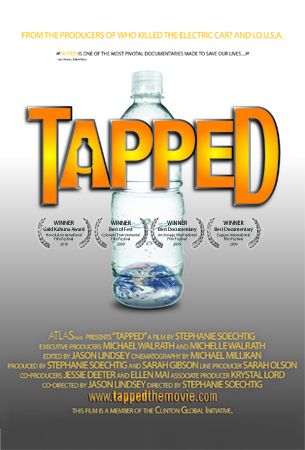
Tapped poster and logos ©AtlasFilms, all rights reserved.
Back in March, we reviewed the stirring documentary Tapped, which chronicles the harmful environmental and health impact of our bottled water addiction. Since our World Water Day 2010 coverage, the filmmakers have embarked on an ambitious “Get Off The Bottle” 30 city, 30 day bus tour, set to conclude on April 22, Earth Day. Tapped director and producer Stephanie Soechtig took time out from the tour to talk to ScriptPhD.com about the tour, their efforts to educate people about bottled water, how the film’s release has impacted her, her wishes for changes in the advertising and marketing of bottled water, and things we can all do to make that happen. Day 2 of our Earth Week coverage continues on the theme of how valuable water is to our environment. For our interview with Stephanie, please click “continue reading.”
ScriptPhD.com: Where did the idea for Tapped come from? What inspired you to make this movie?
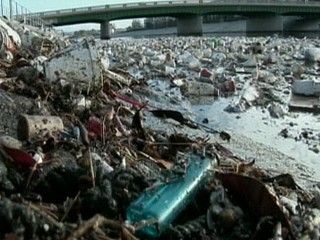
Is this the beach of the future? Garbage washes ashore from remnants of the great Atlantic Garbage Patch. Image ©ABC News.
Stephanie Soechtig: The initial idea for Tapped began with the movie’s executive producer Michelle Wolrath sending me a link to this video about the plastic stew in the Atlantic Ocean [the Atlantic Garbage Patch]. At that time, there was ten times as much plastic as there was plankton, and now we know ten years later that there’s forty times as much plastic as plankton. I saw all that plastic in the ocean and it physically hurt my heart. I thought, “How do we not know about this?” I was a journalist, so I was pretty well-read. And I was also pretty green, so I followed all of these things and I hadn’t heard of it. And so, that led to a continued discussion with my executive producers (a husband-and-wife team) about what other environmental issues might be out there that hadn’t yet been covered. Water and plastic kept coming up. And eventually, [we came to a consensus] to do a movie on bottled water.
SPhD: Can you talk about the arduousness of the filming schedule?
SS: I think that the filming seemed arduous at the time, however now in comparison to the 35-day cross-country trip, it looks like a walk in the park. We got to fly most places [during the filming] and we had a team with us, and everything paled in comparison with what we’re doing now. The toughest part about making Tapped was picking what actually got to stay in the film and what had to be cut, because there was so much to cover, and so the film kept evolving and taking on a life of its own. The filming process, while it was rushed, I have a news background, so I was used to a quick turnaround. It was a really good time, and we had a great group who were all primarily women. We had three moms on the staff, so it was great to create an environment for a group of women who were all looking out for each other.
SPhD: I’m sure you get asked this all the time, but we’ll ask again. A huge thesis of the film Tapped is the dangers of bottled water usage. The number one alternative, of course, is to drink tapped water. However, the documentary Flow raises some questions about the safety of tap water. What is your response?
SS: You know, that’s not the impression I got from Flow. I knew they brought up problems with some tap water, but I always feel like Tapped picks up where Flow left off, with Flow as a perfect companion piece. We are aware that large portions of the country lack access to clean drinking water. We try to say it a few times in Tapped, that we believe there is a time and a place for bottled water. If I was in Mexico, I’m sure I would drink bottled water. And so, if you live in those portions of the country that don’t have access to clean drinking water, perhaps bottled water is a short-term solution. My concern is that I think we have all turned to bottled water as an alternative to tapped water. Rather than raising hell about lack of access to clean drinking water in parts of the country, we’ve just quietly gone and bought bottled water. And I think that sends a really dangerous message to our leaders that tapped water isn’t important to us. While I do think it may be a short-term solution for parts of the country [and world], and for disaster relief and times where it’s a healthier alternative, but for the most part, it’s become a dangerous alternative that has lulled us into this false sense of complacency to think, “OK I can get bottled water, so I’m fine.” As we know, 40% of bottled water is tapped water, so it could be suffering from the same problems depending on the area that it’s bottled in.
SPhD: I’m lucky to live in a part of LA that has really clean tap water, so I don’t have to think twice about drinking tapped water that I quite frankly don’t even filter with a Britta. What do you recommend for people who have seen the film, who want to commit (or recommit) themselves to drinking tapped water, but they might have reticence?
SS: Yes, because again, the municipal supply may be safe, but you don’t know what the pipes are like delivering it. So what I would advise is one of two things. Have your water tested directly from the tap. Either send it out, buy an at-home testing kit, or a lot of the companies trying to sell you a filter will come in and test it for you. See what your water contains and buy the appropriate filter to filter out what you need. We have become fans of the filter called Multipure. The reason we like them is because they have some of the highest official certifications independently tested. And they also have a variety of options—you can have a house filter or a counter-top filter. So we like that they offer that price range for people.
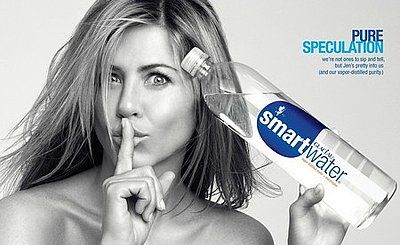
Perhaps it's time for Jennifer Aniston to take her own advice and stop promoting consumption of bottled water, which we have learned is anything but "Smart."
SPhD: We’re big fans of media and advertising at ScriptPhD.com. And one of the things I loved about Tapped is that you talked about the genius advertising and marketing campaigns that have contributed to the popularization of bottled water. When you have famous celebrities like Jennifer Aniston endorsing SmartWater, could celebrities be convinced to not only end these endorsements but to promote something as unsexy as drinking tapped water?
SS: I would love that. If that’s the only thing that Tapped accomplished, and we didn’t sell a DVD for my whole life, I’d die a happy woman. That type of accomplishment and that type of endorsement of protecting our tapped water is long overdue and needed, but the municipalities don’t have the multi-million dollar budgets a company like SmartWater has. Speaking frankly, what I find upsetting is these people that make plenty of money on the films that they do—like Jennifer Aniston, who’s doing very well—would lend their faces to tap water and repairing the infrastructure. Which may be less sexy, but then again, that’s why you need someone like Jennifer to raise the awareness to it. We live in a celebrity-driven culture. It troubles me that she would endorse a product like this, and I have to honestly believe that she just does not know the truth about bottled water. That’s why we have a petition to her [and SmartWater endorser Tom Brady] on our website asking them to end their endorsement.
SPhD: It’s funny to me how plastic bottle manufacturers react to movies such as yours or anyone that brings up the deleterious issues of bottled water. Recently, for example, Dasani, which is a brand featured in the film, announced that they’re manufacturing bottles made partially out of “biodegradable” plant material. Meaningful change or greenwashing?
SS: I think it’s greenwashing. I wish it wasn’t. I wish I didn’t believe this. First of all, the fine print on the new Dasani plant bottle says “up to 30% of biodegradable material,” and that’s such a scam. Up to 30% could mean anything. The second problem is that they continuously sabotage the Bottle Bill, which we know increases recycling and has a proven rate of return. So putting 30% of plant material in a plastic bottle only makes it less recyclable because we don’t have the recycling facilities to process that type of material. It also emphasizes to me that they continuously argue against people like me, that plastic isn’t bad for you and I’m some crazy fearmonger. Well, if plastic isn’t bad for you, then why are they switching? I feel like they’re only underscoring my concerns about plastic.
SPhD: Well, it’s a well-known fact that the FDA has ignored BPA safety for quite some time, and is only now embarking on a controversial $7 million dollar study, when we know the ill-effects of this compound well and good. It sort of feels like the government has their hands tied behind their backs in terms of any meaningful change.

Kleen Kanteen metal water bottles such as these (and their equivalents on the market) are BPA free and can help severely diminish waste generated from use of plastic water bottles.
SS: And I’d say that they have their hands tied behind their backs by large lobbying dollars. As we have seen, money talks, and the public is sadly not a priority. The really interesting thing to learn was about the Toxic Substance Control Act. It’s 34 years old, and the burden of proof on the EPA to say that a chemical is dangerous can only be attained from the information that the chemical industry provides. So what happens is that I think BPA is safe, and I hand in to the EPA or the FDA my findings. But I make $11 billion off of this product, so I’m not going to hand in findings that show that anything is wrong with it. At the EPA and the FDA, I’m not given a budget to challenge these things. They only look at their science to raise concerns about their product. There is nothing logical about that.
SPhD: Let me ask you this, since you are literally on your road trip as you’re talking to us. What has been the response from people who have viewed the film and interacted with you during the 30 day road trip?
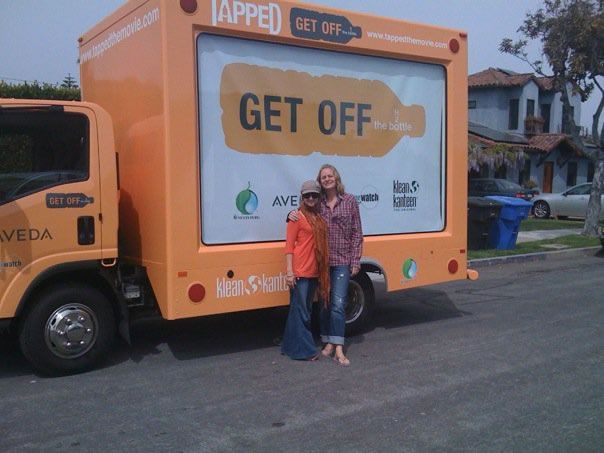
Stephanie Soechtig (left) and producer Michelle Wolrath (right) on their massive 30-day Tapped Get Off The Bottle tour. Kudos, ladies!
SS: We’re definitely making an impact. And that’s kind of the fuel that keeps us going every day. [For] people in the theatres, after Tapped ends, it’s nothing short of magical what happens after those Q&As. People are pissed, they’re inspired, and they become aware during the question and answer session how much the burden of change lies on their shoulders. So they look at us and say “Now what?!” and I would respond that it’s up to you. This movie is just something we created as a tool to bring about change. We’re heavily reliant on the public to spread this word, to say that this is important to them, and to make sure that they get it out there. And they’re into it! Which is so awesome to see. People will commit, come out and buy five DVDs at a time because they want to send it to everyone that they know.
SPhD: I think it’s such an important new methodology of enacting change. Fight corporate cash with grassroots power!
SS: I hadn’t realized how difficult it was to enact change with a grassroots movement. I thought people would naturally come out in the thousands and be like, “Of COURSE we care about tapped water.” But it’s not quite as easy as I had hoped it would be. It’s a very slow-growing movement, and of course we also have the problem of media that’s also beholden to advertising dollars. This makes it difficult to get the kind of exposure that may help us reach a larger audience. So we’re literally doing it one room at a time.
SPhD: One of the themes we continually come back to is corporations’ advertising dollars and power. One of the biggest corporations covered in Tapped is Nestle, for both their egregious practices of pumping water out of communities as well as how much they collude with plastic manufacturers. Any ramifications for these companies because of your movie and advice for customers that want to use their wallets to make a statement?
SS: We have seen bottled water sales go down this past year. Bottled water sales were doing nothing but going up for the past ten years. This past year we saw a slight dip. The water industry credits it to the recession. And that may absolutely have a lot to do with it, but I think there’s been a bottled water backlash, fueled in part by Tapped and grassroots organizations working tirelessly to get the word out there. So I think there are repercussions, and I think they’re getting desperate. There’s this guy, Tom Lauria, who is the lobbyist for the International Bottled Water Association, and if you go online to look at any story about Tapped or more recently about the story of bottled water, you’ll see he writes in to discredit the film. He spends his whole day doing it. The interesting thing about Tom Lauria is that he used to be the head lobbyist for the tobacco industry, and I think that’s no coincidence—that the bottled water industry would seek out someone who has that background, given the information that is coming out about both the environmental damage and the chemical dangers that people may be experiencing.
As far as consumers, the easiest thing is to not buy bottled water. I would say taking the Bottled Water pledge that we have on our site, which then gets sent to bottled water companies to show them how many people have agreed to give up their habit. And lastly, I think people underestimate the power of writing a note and complaining and fighting legislation and paying attention to the people we elect and letting them know what is important to us. Don’t sit back and hope that things will somehow take care of themselves. We have made it easy for people on the Tapped website to find and sign petitions.
SPhD: How has your consumption and behavior changed after the making of this movie?
SS: I formed a lot of new habits by bringing a Kleen Kanteen water bottle with me everywhere I go. But it’s actually changed my life in so many other ways, in trying to generate as little waste as possible. During the making of this film, I had a Starbucks latte waiting for me every morning. When you see the Garbage Patch, you realize it’s not just water bottles. They’re a big offender, but you start to cut down on all waste. We bring our mugs now when we want to get coffee, we stay away from plastic Tupperware, try to stay away from any plastic whatsoever. When I order food to go, I ask them to wrap it in tin foil. I’m just much more aware of how much plastic is out there, and how mindlessly we grab for it. It’s just the little things. Like for our road trip, one of our producers brought a Tupperware filled with silverware so that we wouldn’t use plastic knives and forks. Some people go to more extreme measures than others. And I have just decided that the message we need to send is that doing anything is better than doing nothing. Don’t think that any task or any sacrifice is too small.
*********
Tapped trailer:
A list of things you can do RIGHT NOW to get off of bottled water and help save our environment.
Urge a member of Congress to support The Water Protection and Reinvestment Trust Fund by signing a petition.
Visit the World Water Day website to find out about the global water crisis and see what you can do to make a difference.
CaptainPlanet is an LA-based, Northwestern University-educated, eco-charged sustainability guru who loves film, psychology and saving the planet, one waterless urinal at a time…
~*CaptainPlanet*~
*****************
ScriptPhD.com covers science and technology in entertainment, media and advertising. Hire our consulting company for creative content development.
Follow us on Twitter and our Facebook fan page. Subscribe to free email notifications of new posts on our home page.
]]>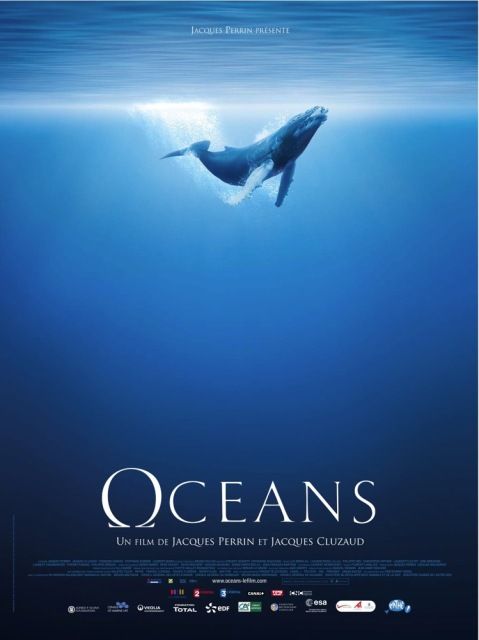
Oceans film poster and associated images ©DisneyNature Films, all rights reserved.
Happy Earth Week 2010, everyone! Here at ScriptPhD.com, we have devoted a number of articles to environment, sustainability and eco-awareness as part of our continuing “It’s Not Easy Being Green” series. This year, in celebration of the 40th anniversary of Earth Day, we are devoting the entire week to articles, interviews and profiles of companies, individuals and content that raises awareness of sustainability efforts and new ideas for the green science revolution. Because water lies at the heart of most modern environmental crises, we kick off Earth Week with CaptainPlanet’s review of the stellar new DisneyNature documentary Oceans, a truly spectacular oeuvre that celebrates the majesty of our most important and delicate resource. We also include a number of practical, easy things you can do right now to make a difference globally by acting locally. For our Oceans review and to find out what you can do to help protect our Earth’s water supply, please click
the “continue reading” cut.
When I was three years old, my parents took me on a vacation to Atlantic City. It was my first time ever to see the ocean, and my parents were excited to see my reaction at seeing the water when we arrived at the beach that morning. Although I don’t remember the experience, I’ve been told that when I first set foot on the beach, I had a very concerned look on my face when I saw the waves pounding the shore. I ventured closer to the water to get a closer look, and upon surveying the incoming waves, I promptly turned on a dime and outran my parents back to the hotel without stopping. When my parents finally caught up with me to find out the reason for my distress, I said, “the river came out of itself,” in awestruck horror at the ocean’s power.
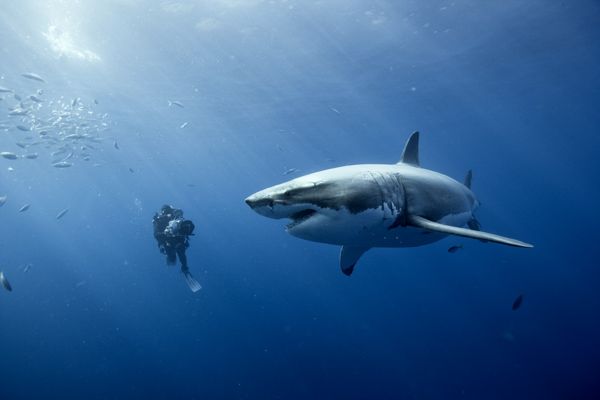
A great white shark is far more tempted by the small fish than a human diver swimming alongside him in a scene from Oceans.
Oceans, a DisneyNature documentary premiering in theatres on Earth Day, April 22, 2010, opens on a similar theme of childhood wonder as a little boy on a beach stares out at the vastness of the ocean before him and wonders what an ocean is. As children, before we learn names for what things are called, and prior to learning about taxonomical categories in biology courses, staring at an ocean and all of its inhabitants is truly an exercise in wonder. Oceans ignites that childlike wonder while exploring the richness, beauty, danger and primordial nature of the sea. Directors Jacques Perrin and Jacques Cluzaud clearly have a knack for inciting wonder. Perrin directed the acclaimed The Winged Migration in 2001 and Cluzaud’s resume features work in IMAX films and innovative projection techniques.
Disney launched the DisneyNature label after the worldwide success of March of the Penguins in 2004. Their mission is to release one nature-related documentary per year to raise awareness about the interconnectedness of humans and nature, including what actions we can take to positively impact the environment. It is promising to see a global media corporation as hefty as Disney champion sustainability in a serious way. And it will be clear to anyone who sees Oceans, a top-notch production with stunning cinematography, narration and musical score, that Disney spared no expense to produce this film.
Pierce Brosnan, the film’s narrator, seems to have found a daft second career in narration, starting with his excellent work on the pre-recorded audio tour of the 2006 Magritte exhibit at the Los Angeles County Museum of Art. Brosnan’s voice, retaining the suaveness of his 007 days, guides us on a journey through waters of the globe. It seems at times as though the film has managed to capture every single creature that inhabits the oceans, as impossible as that would be. From whales, dolphins, sharks, sea lions, polar bears, otters, fish, crabs, shrimp, plankton, turtles, to penguins, octopi, jellyfish, and many more, it’s easy to forget just how many members of the animal and plant kingdom reside in the oceans.
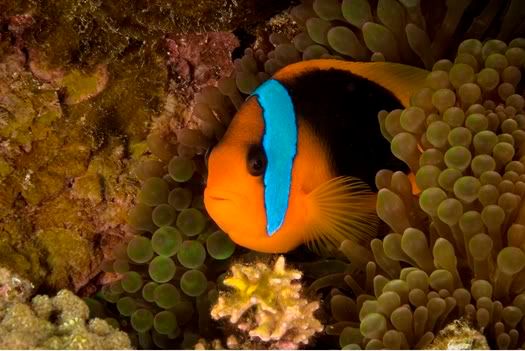
This clownfish in his natural environment is just one of many breathtaking examples of how vibrant and vivid our undersea environment really is.
In one of the film’s most breathtaking sequences, we witness a school of sardines massacred from above and below by an army of birds, dolphins, sharks and blue whales. The sequence is an orgiastic feeding frenzy, shot from above, on the surface and underwater, accompanied by a kinetic musical score. The different animals in this sequence appear so choreographed that they invoke the ballet of dancing hippos, ostriches and alligators from the “Dance of the Hours” sequence from Disney’s animated Fantasia masterpiece. The sequence ends with a blue whale breaching the surface in the center of concentric rings of dolphins, fish and birds, a prima ballerina taking her bow.
Oceans is primarily a love letter to our world’s oceans, surveying the various topographies and lifeforms of the world beneath the surface that we often take for granted. Fortunately the film doesn’t shy away from discussing the danger that human activity poses to oceans. Although Oceans was never intended to be a hard-hitting piece of environmental journalism, it does strike a good balance between education and advocacy. The film highlights how advances in satellite imagery allow us to see where industrial pollution flows from rivers out into the open ocean, much the same way a calcified artery might appear on a heart scan. In a regular satellite photo, the river appears to be as blue as the ocean, but when the view switches to the new technology, the pollution in the river, heretofore unseen, materializes in the photo as a black, foreboding stream. The oceans have become humanity’s dumping ground for hundreds of millions of tons of trash each year. In another sequence, we see gigantic fishing nets that sweep vast swaths of water, a practice known as trawling, decimating global fish populations and killing other animals unlucky enough to get caught in the vast net. And in Antarctica, we are shown how rising global temperatures have resulted in the demise of the polar ice caps. Though the film doesn’t broach the topic directly, human water consumption is another imminent crisis facing our oceans. In a brilliant editorial, National Geographic Society chairman Gilbert Grosvenor discusses how human water usage is unsustainable and touts a National Geographic issue devoted entirely to water. (Download here.) Towards the end of Oceans, Brosnan boldly (and correctly) states that the greatest threat to the ocean is human indifference. We hope that you attend, absorb and engage in activism, even at the most basic levels to prove him (and all of us) wrong.
Coinciding with the film’s release, Disney has launched a campaign, in partnership with The Nature Conservancy, to create a protected area of coral reef in the Bahamas. Each moviegoer who attends an Oceans screening in the first week of the film’s release will help contribute to the cause. The campaign for the previous DisneyNature release, Earth, resulted in the planting of an astonishing 2.7 million new trees in the Amazon rainforest. The Nature Conservancy, founded in 1951, protects more than 119 million acres of land, 5,000 miles of rivers, and 100 marine conservation projects globally. With a staff of more than 700 scientists, they pursue their goals through science-based, non-confrontational strategies.
Oceans Trailer:
Oceans goes into wide release on Earth Day, April 22, 2010 at theatres nationwide.

•Contact your congressional representatives to voice your support for the Oceans-21 Act: a bill that adopts the key recommendations of the U.S. Commission on Ocean Policy and the Pew Oceans Commission to develop a holistic ocean health plan. This bill, unlike past ocean legislation, treats the disease, not the symptom.
•Educate yourself about the sustainability of seafood. Check out “Bottomfeeder: How to eat ethically in a world of vanishing seafood” by Taras Grescoe.
•Check out the Monterey Bay Aquarium’s guide to seafood
•Volunteer or donate to ocean related organizations. If you live by a coastal area, attend a beach clean-up.
•If going on a cruise, choose an environmentally friendly cruise line
•Support elected officials who support the ocean.
•Keep trash out of the oceans—if you don’t already, recycle, reduce, reuse and compost as much of your waste in your home and office as possible. Earth911.com is an exceptional resource for tips on recycling, finding ways to be greener, reduce waste, and purchase products made of recycled materials.
•Have more ideas for us? We’d love to hear about them in our comments section.
CaptainPlanet is an LA-based, Northwestern University-educated, eco-charged sustainability guru who loves film, psychology and saving the planet, one waterless urinal at a time…
~*CaptainPlanet*~
*****************
ScriptPhD.com covers science and technology in entertainment, media and advertising. Hire our consulting company for creative content development.
Follow us on Twitter and our Facebook fan page. Subscribe to free email notifications of new posts on our home page.
]]>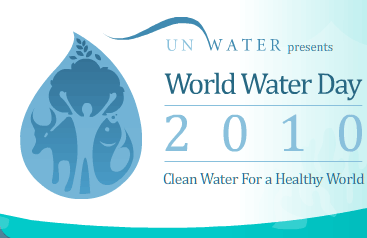
“Whiskey is for sipping, but water’s for fighting.” —Mark Twain
Today, March 22, 2010, is World Water Day, an initiative formed at the 1992 United Nations Conference on Environment and Development. As we head into Earth Day next month, no environmental issue carries more sociopolitical, economic and health ramifications than a clean and abundant supply of water. Some of the highest global morbidity and mortality rates are directly related to lack of access to clean water—both in contracting communicable diseases as well as agricultural impact that aggravates famine. At the heart of this discussion is a frenzied (and growing) thirst for bottled water; Americans alone bought more than 29 billion bottles in 2007. If you have long suspected that bottled water is not good for the environment, but only had a hazy notion about the specific consequences of the bottled water industry, Tapped, an Atlas Films documentary about to be released on DVD, will knock your socks off. The film expertly chronicles the insidious practices of bottled water companies and the dire consequences it has on our collective health, communities, environment, economy and policy in ways you never would have imagined. Our special World Water Day post under the “continue reading” cut.

75% of the earth’s surface is covered with water and less than 3% of that is drinkable. Image ©UNESCO/I. Forbes
Tapped features sparkly footage of bodies of water the world over, from oceans to rivers, lakes, ponds and streams. The sounds of burbling brooks and waterfalls throughout the film feel primal and urgent, as much a reminder of nature’s fragile beauty as they are a ticking clock, and the countdown is not in our favor. An opening salvo in the film’s first sequence sets the tone with a chilling statistic: by 2030, two thirds of the world will lack access to clean water. The film quickly segues into a scary question that is explored throughout the film; what happens if you take water, a requirement for life on earth, and turn it into a commodity, controlled by private corporations?
The answers are disturbing.
The first third of the film focuses on the three largest bottled water companies in America; Nestle, Coke and Pepsi. Nestle operates in the United States under multiple brands, including Poland Springs, Arrowhead, Ozarka, Ice Mountain, Deer Park and Zephyrhills. Coke owns Dasani and Pepsi owns Aquafina. Bottled water started as a small trend in America in the 1970s when Perrier introduced bottled sparkling water to urban professionals by way of small green glass bottles. But it wasn’t until 1989 when plastic bottles made from more mobile and lightweight PET plastic were introduced that the business really took off. At that point Coke and Pepsi got into the game because their soda sales were declining. The industry continued to grow at explosive rates, and by 2007 Americans inexplicably spent more than $11.7 billion on a free natural resource, something that was rightfully pegged in the film as “one of the greatest advertising and marketing feats of all time.”
Where these companies get their water is a controversial issue. Often, they buy small, cheap plots of land in small communities, install a water pump to access the community’s underground supply, and pump to their heart’s content with little-to-no overhead, taxes, regulation or accountability. The laws governing water usage in the US make this scenario possible. Surface water (oceans, lakes, rivers, etc.) is held as a public trust, and hence protected from poaching, or water mining, as the practice is often called. The loophole, however, is that underground water in most states is governed by a law established in the late 1800s called “absolute dominion,”
which basically translates to “he who has the biggest pump gets the most water.”
Small communities all over the country have been subject to this process, and often don’t know it’s happening until the corporations have already set up an operation. Communities in these situations have started organizing to stop the corporations from taking their water, but it is an uphill battle as corporations have teams of lawyers, lobbyists and other resources to advance their interests. In one small town in Maine profiled in the film, Nestle has set up a Poland Springs pump where it costs about six cents per gallon to pump water out of the ground. (A recent fight by Maine citizens, documented here and here has caused considerable headaches to Poland Springs.) The corporations then turn around and sell the water for $6.00 per gallon. This practice is happening in states around the country including California, Colorado, Arkansas and Michigan. The film points out that these corporations are setting a dangerous precedent that will allow them to control water sources in the future, which is why activists and concerned community members are desperately fighting to change the laws. Even citizens of Serbia, the birthplace of ScriptPhD.com editor Jovana Grbić, are crying out against privatizing and selling its 300 natural springs, the most abundant in all of Europe, for water production.
When Congress tried to hold the water manufacturers accountable for depleting municipal water sources in times of drought, Pepsi testified that their water pumping had nothing to do with lowering the water levels of the local lakes and rivers. In a particularly surreal moment of the film, a Pepsi official tells a congressional panel with a straight face that beavers and their dams are to blame for lowered water levels. Dennis Kucinich (D, Ohio), the congressman leading the panel, counters back, “How many beavers would that take?” It might be funny if it weren’t so alarming. Take a look at this CNN report that resulted from revelations during the Congressional hearings:
The Environmental Devastation of Plastic
Act II of Tapped reveals the deleterious ecological and health fall-out from plastic bottles. Most of the bottles end up in a landfill or the Pacific Ocean. Often called “The World’s Largest Dump,” the Western Garbage Patch, located between Hawaii and California, is twice the size of Texas and largely composed of plastic. (An Eastern patch also exists, and video of it has been compiled here by the marine research group Algalita.) The film takes us to a bottling plant in Corpus Christi, Texas where local residents are dying from cancer due to the benzene emissions from the plant. They are often stuck living in a dangerous situation because no one wants to buy their home due to the close proximity to the plant. The film interviews several of these residents in one of the saddest moments of the documentary. One such interviewee, a man dying of cancer, says that were it not for the love of his family, he would feel like a piece of trash, his body the unwilling receptacle for toxic emissions from the faceless corporation making plastic bottles in his backyard. This man died shortly after the making of the film, and the film is dedicated to his memory.
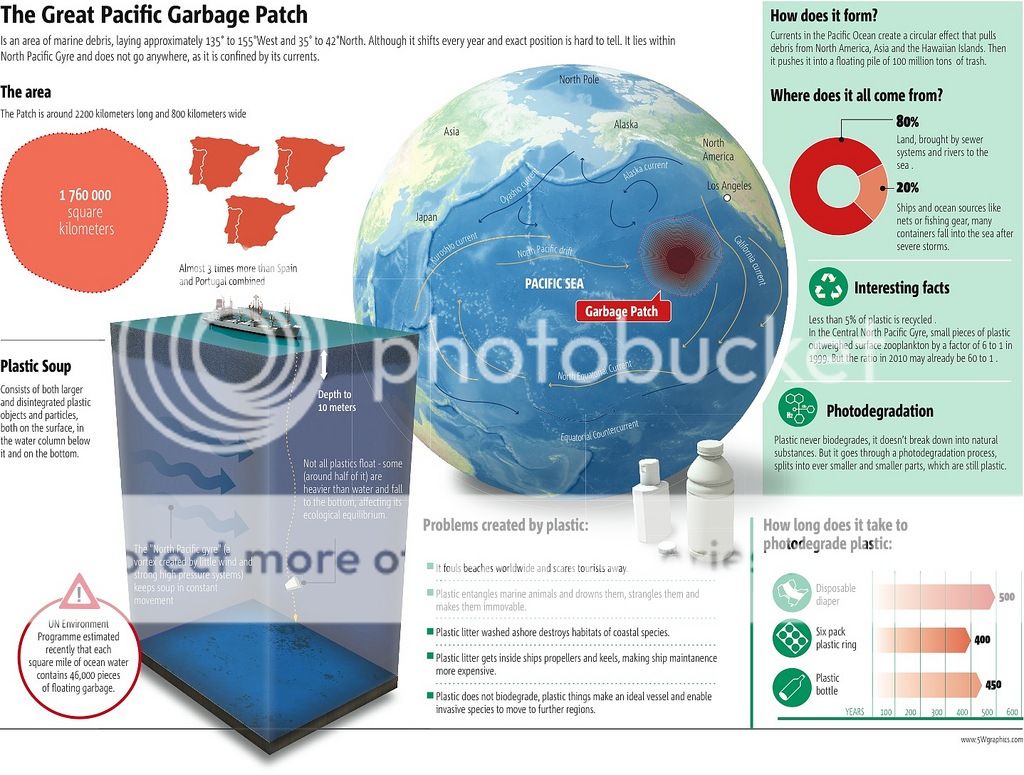
Infographic on the Great Pacific Garbage Patch, courtesy of www.5WGraphics.com. Click on the picture for a higher resolution image.
Captain Charles Moore, the founder of Algelita, appeared last week on David Letterman’s show to discuss the Garbage Patch:
About 40 minutes into the film there is a quick shot of a customer at Whole Foods placing his groceries on the conveyor belt at the cash register. The camera angle is low enough so we don’t see his face or the cashier’s face. We only see what he is buying; a sandwich, a bag of chips and a bottle of Smart Water. The image is a punch to the gut because that nameless, faceless scene has been me, too many times to count, and most likely it’s been you as well. The scene is a subtle reminder that every time we purchase a bottle of plastic water, we’ve voted “yes” for a system that is killing poor families in Corpus Christi (and elsewhere) and littering beaches in Hawaii with such large amounts of plastic that an army of dump trucks couldn’t clean it up. Even more insidious is the amount of microscopic plastic particles floating around in oceans from thrown-away plastic bottles. When one activist scoops up a handful of sand from a Hawaii beach, it looks like he’s holding a fistful of pulverized Lego’s; the plastic particles quickly replacing the sand particles. This is a result of what happens when people don’t recycle their bottles. Bottles left on the street are picked up by rainwater and washed into rivers and stream, and ultimately end up in the oceans. But recycling bottles is not exactly an entirely sustainable solution either, as the film points out. Municipalities who produce tap water, and who are in direct competition with bottled water, are often left holding the tab to recycle the leftover plastic bottles from their competitors, but with only a fraction of the budget that the corporations have.
BPA: Dangerous Chemistry
A more worrisome horror of plastic bottles is an insidious chemical called bisphenol A (BPA), used to make the hard, clear 5-gallon kind bottles most often found at a water cooler. Frederick Vom Saal, PhD at the University of Missouri, Columbia is a leading expert on BPA and its effects on human health. He calls it one of the most potent, toxic chemicals known to man because even in small amounts, it profoundly disrupts every single part of the developing male reproductive systems in lab animal studies, even at doses 25,000 smaller than any dose that has ever been studied. In larger doses, it disrupts the thyroid gland, and its been linked to a plethora of diseases from cancer to obesity, diabetes, and attention deficit and hyperactivity disorder. A recent study even found a link between BPA exposure and permanent fertility effects. These diseases have been killing people at increasingly higher rates over the last 30 years, a direct correlation to the amount of BPA floating around in consumer products over the same period of time. The FDA has not closely regulated BPA and for a long period of time, as the film reveals, relied on studies from bottle manufacturers (the people who make bottles out of BPA for a living!) that state BPA is not dangerous in small quantities. The Huffington Post recently published a series of articles revealing that BPA is found in cash register receipt paper and cardboard pizza boxes, among a host of other everyday items.

The plastic culprit bis-phenol A
In a particularly effective scene from the film, filmmaker Stephanie Soechtig boldly asks an FDA official about their role in regulating BPA. A furious FDA press official abruptly interrupts the interview from off screen and states that if he knew BPA would be discussed, he wouldn’t have allowed the interview. The failure of the FDA to protect the public from a chemical as dangerous as BPA could be the last straw in the public’s tolerance for government incompetence and corruption, which explains why the FDA doesn’t want to discuss such a volatile subject. BPA is found in a whole host of consumer products including dental fillings, canned foods, food wrappers, food labels, and baby bottles. The good news is that due to mounting public and scientific pressure, the FDA is conducting a new study on the safety of BPA, but the $7-billion-a-year BPA industry will surely put up a fight to stop any regulation. To protect your own health, the film’s website says you should look for “BPA Free” labels whenever you buy hard plastic and avoid eating canned foods or drinking from hard plastic water bottles.
The soft plastic water bottles that most of us drink from do not contain BPA, but that doesn’t mean they are safe. As one expert in the film says, we don’t know the long term effects of drinking from PET plastic bottles. A recent British study showed that pregnant women exposed to phthalates, common across all plastics, gave birth to babies with gender defects. And in a particularly disturbing sequence from the film, the crew of Tapped buys their own samples of bottled water and sends them to toxicology labs for testing. Due to the large marketing and advertising budgets of bottled water makers, we have been led to believe for a long time that bottled water is safer than tap water. But the list of chemicals found in the bottled water, including styrene, dimethyl phthalate, and di-n-octyl phthalate, shatters that notion.
Tapped ends on a hopeful note, reminding us that change is possible, and highlighting the various battles that water activists and concerned citizens have won in recent years along with some tips for the consumer to drink filtered tap water from a reusable water container and to urge leaders to invest in our municipal water infrastructure. The Mayor of San Francisco banned bottled water at any municipal or government location. Seattle banned sales altogether at city events. Perhaps change is in effect. News outlets reported late last year that bottled water sales are starting to slump for the first time.
Look for Part II of this article containing an exclusive ScriptPhD.com Q&A between CaptainPlanet and filmmaker Stephanie Soechtig in the coming week as we continue to explore conservation issues and what can be done to enact positive change.
Take a look at this hair-raising 5:00 extended Tapped trailer:
Tapped is slated for official DVD release (with bonus features) May 1. Visit their store to purchase the DVD and Kleen Kanteen PBA-free water bottles.
CaptainPlanet is an LA-based, Northwestern University-educated eco-charged sustainability guru who loves film, psychology and saving the planet, one waterless urinal at a time…
~*CaptainPlanet*~
*****************
ScriptPhD.com covers science and technology in entertainment, media and advertising. Hire our consulting company for creative content development.
Follow us on Twitter and our Facebook fan page. Subscribe to free email notifications of new posts on our home page.
]]>













